The History Book Club discussion

This topic is about
The Splendid and the Vile
BUDDY-READS
>
ARCHIVE - BUDDY READ - THE SPLENDID AND THE VILE: A SAGA OF CHURCHILL, FAMILY, AND DEFIANCE DURING THE BLITZ - DISCUSSION THREAD (No Spoilers, please)
This Was Queen Elizabeth II's First Speech
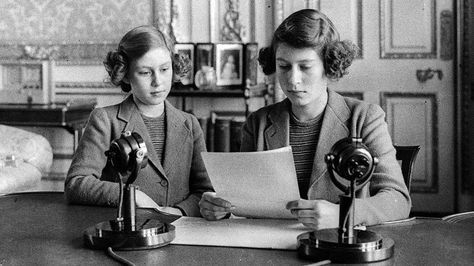
In 1940, Princess Elizabeth was tasked with an important job by prime minister Winston Churchill: to give a morale-boosting radio speech to her weary subjects during WWII, from historic Windsor Castle.
Link: https://youtu.be/x2DQYMwAM9g
Source: Smithsonian Channel
Princess Elizabeth Broadcasts To The Nation on Children's Hour (1940) | War Archive
Princess Elizabeth (now The Queen) and her sister Princess Margaret speak to the nation on Children's Hour in 1940. They speak to the children who have found new war time homes in Canada, Australia, New Zealand, South Africa, and the United States of America.
Link: https://youtu.be/89CJ_8lqDdA
Source: Youtube
BBC full version:
Link: https://youtu.be/VJI9LPFQth4

In 1940, Princess Elizabeth was tasked with an important job by prime minister Winston Churchill: to give a morale-boosting radio speech to her weary subjects during WWII, from historic Windsor Castle.
Link: https://youtu.be/x2DQYMwAM9g
Source: Smithsonian Channel
Princess Elizabeth Broadcasts To The Nation on Children's Hour (1940) | War Archive
Princess Elizabeth (now The Queen) and her sister Princess Margaret speak to the nation on Children's Hour in 1940. They speak to the children who have found new war time homes in Canada, Australia, New Zealand, South Africa, and the United States of America.
Link: https://youtu.be/89CJ_8lqDdA
Source: Youtube
BBC full version:
Link: https://youtu.be/VJI9LPFQth4
message 53:
by
Bentley, Group Founder, Leader, Chief
(last edited May 29, 2020 12:34AM)
(new)
-
rated it 4 stars
Buckingham Palace
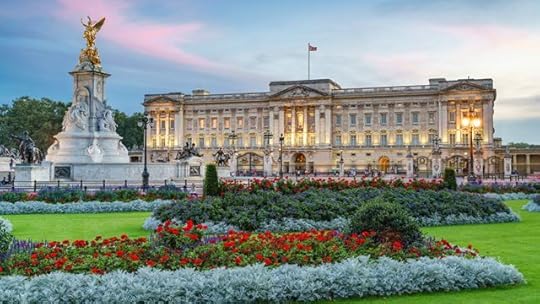
360° Video: Buckingham Palace Tour - BBC London
Link: https://youtu.be/FtGN2wK9g_s
Sources: Wikipedia, Buckingham Palace, London and Partners

360° Video: Buckingham Palace Tour - BBC London
Link: https://youtu.be/FtGN2wK9g_s
Sources: Wikipedia, Buckingham Palace, London and Partners
message 54:
by
Bentley, Group Founder, Leader, Chief
(last edited May 29, 2020 12:47AM)
(new)
-
rated it 4 stars
St. James Park
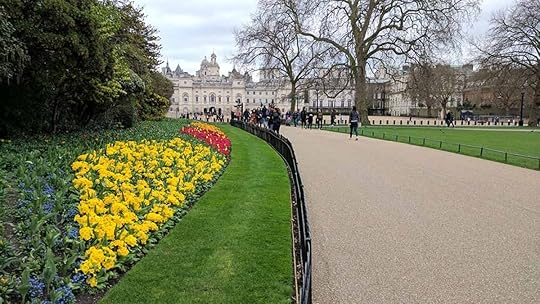
More:
London's St. James's Park is a great place to take a break while in the heart of London. It's located in front of Buckingham Palace and is an easy walk to dozens of must see places including Buckingham Palace, Trafalgar Square, Horse Guards Parade, Parliament, West Minster Abbey, Whitehall and so much more.
Link: https://youtu.be/KwuI6warbdk

More:
London's St. James's Park is a great place to take a break while in the heart of London. It's located in front of Buckingham Palace and is an easy walk to dozens of must see places including Buckingham Palace, Trafalgar Square, Horse Guards Parade, Parliament, West Minster Abbey, Whitehall and so much more.
Link: https://youtu.be/KwuI6warbdk
message 55:
by
Bentley, Group Founder, Leader, Chief
(last edited May 29, 2020 02:30AM)
(new)
-
rated it 4 stars
MAY, 1940 GERMAN INVASION OF HOLLAND & LUXEMBOURG WWII NEWSREEL 32590b HD
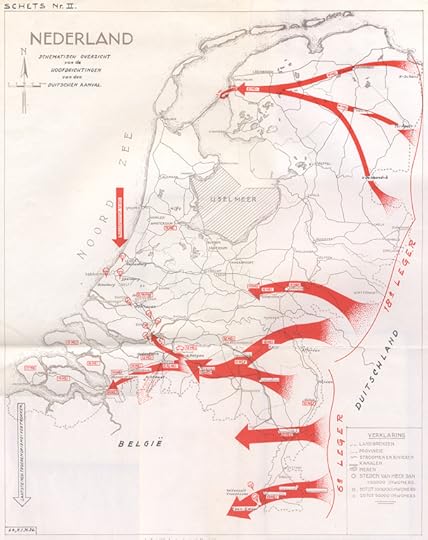
Made for the home market and released in German in 1940, this short silent newsreel shows the Wehrmacht invasion of Holland and Luxembourg. Note: - Silent German Propaganda Film at the time
The film begins with images of German tanks moving into Holland, and engineers working to remove roadblocks and damaged steel from bridges. At :56 motorcycle troops rumble into Holland. (The Germans seem unstoppable and are shown advancing with tanks, armored cars, motorcycles and even on a railway "speeder" at 1:14!)
At 1:31 the Juliana Canal named after Queen Juliana of the Netherlands, is shown. This is a 36 km long canal in the southern Netherlands, providing a bypass of an unnavigable section of the river Meuse between Maastricht and Maasbracht. At 1:44 German engineers install a floating pontoon bridge to replace one bombed. Troops advance using small rubber boats.
At 2:30 horses are used to pull artillery across a river. At 2:53 Junkers Ju-52 aircraft are shown, as well as Dornier bombers at 3:05. The Ju-52s release paratroops at 3:20. The paratroops occupy bridges and rapidly form up. At 4:00 the burning docks of what must be Antwerp or Rotterdam are shown. At 4:19 a German convoy moves through shattered streets. Fires burn at 4:40, probably in Rotterdam.
The Battle of the Netherlands was a military campaign part of Case Yellow, the German invasion of the Low Countries (Belgium, Luxembourg, and the Netherlands) and France during World War II. The battle lasted from 10 May 1940 until the surrender of the main Dutch forces on 14 May. Dutch troops in the province of Zeeland continued to resist the Wehrmacht until 17 May when Germany completed its occupation of the whole country.
The Battle of the Netherlands saw some of the earliest mass paratroop drops, to occupy tactical points and assist the advance of ground troops. The German Luftwaffe used paratroopers in the capture of several airfields in the vicinity of Rotterdam and The Hague, helping to quickly overrun the country and immobilise Dutch forces.
After the devastating bombing of Rotterdam by the Luftwaffe on 14 May, the Germans threatened to bomb other Dutch cities if the Dutch forces refused to surrender. The General Staff knew it could not stop the bombers and ordered the Dutch army to cease hostilities. The last occupied parts of the Netherlands were liberated in 1945.
Link: https://youtu.be/Rx2E6jkhDoE
News Film - Netherlands Information Bureau
Shows the dreadful purposeful breaching by the Germans of the dike in the Netherlands - flooding the land and the burning of cities. Germans had destroyed everything in their path.
https://www.youtube.com/watch?v=R_AbC...
Sources: Youtube, Periscope LLC on Youtube, Netherlands Information Bureau

Made for the home market and released in German in 1940, this short silent newsreel shows the Wehrmacht invasion of Holland and Luxembourg. Note: - Silent German Propaganda Film at the time
The film begins with images of German tanks moving into Holland, and engineers working to remove roadblocks and damaged steel from bridges. At :56 motorcycle troops rumble into Holland. (The Germans seem unstoppable and are shown advancing with tanks, armored cars, motorcycles and even on a railway "speeder" at 1:14!)
At 1:31 the Juliana Canal named after Queen Juliana of the Netherlands, is shown. This is a 36 km long canal in the southern Netherlands, providing a bypass of an unnavigable section of the river Meuse between Maastricht and Maasbracht. At 1:44 German engineers install a floating pontoon bridge to replace one bombed. Troops advance using small rubber boats.
At 2:30 horses are used to pull artillery across a river. At 2:53 Junkers Ju-52 aircraft are shown, as well as Dornier bombers at 3:05. The Ju-52s release paratroops at 3:20. The paratroops occupy bridges and rapidly form up. At 4:00 the burning docks of what must be Antwerp or Rotterdam are shown. At 4:19 a German convoy moves through shattered streets. Fires burn at 4:40, probably in Rotterdam.
The Battle of the Netherlands was a military campaign part of Case Yellow, the German invasion of the Low Countries (Belgium, Luxembourg, and the Netherlands) and France during World War II. The battle lasted from 10 May 1940 until the surrender of the main Dutch forces on 14 May. Dutch troops in the province of Zeeland continued to resist the Wehrmacht until 17 May when Germany completed its occupation of the whole country.
The Battle of the Netherlands saw some of the earliest mass paratroop drops, to occupy tactical points and assist the advance of ground troops. The German Luftwaffe used paratroopers in the capture of several airfields in the vicinity of Rotterdam and The Hague, helping to quickly overrun the country and immobilise Dutch forces.
After the devastating bombing of Rotterdam by the Luftwaffe on 14 May, the Germans threatened to bomb other Dutch cities if the Dutch forces refused to surrender. The General Staff knew it could not stop the bombers and ordered the Dutch army to cease hostilities. The last occupied parts of the Netherlands were liberated in 1945.
Link: https://youtu.be/Rx2E6jkhDoE
News Film - Netherlands Information Bureau
Shows the dreadful purposeful breaching by the Germans of the dike in the Netherlands - flooding the land and the burning of cities. Germans had destroyed everything in their path.
https://www.youtube.com/watch?v=R_AbC...
Sources: Youtube, Periscope LLC on Youtube, Netherlands Information Bureau
message 56:
by
Bentley, Group Founder, Leader, Chief
(last edited May 29, 2020 02:32AM)
(new)
-
rated it 4 stars
Overview of beginning of World War II - Khan Academy
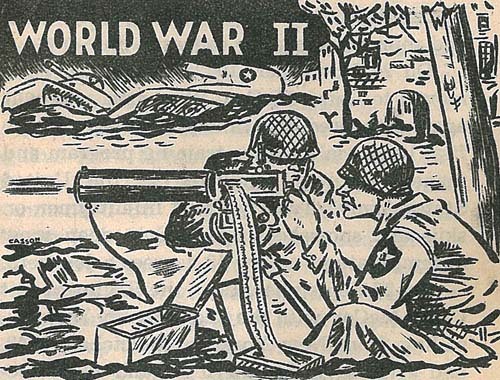
Link: https://www.khanacademy.org/humanitie...
Source: Khan Academy

Link: https://www.khanacademy.org/humanitie...
Source: Khan Academy
message 57:
by
Bentley, Group Founder, Leader, Chief
(last edited May 29, 2020 02:24AM)
(new)
-
rated it 4 stars
Germans Invading Belgium: (Silent)
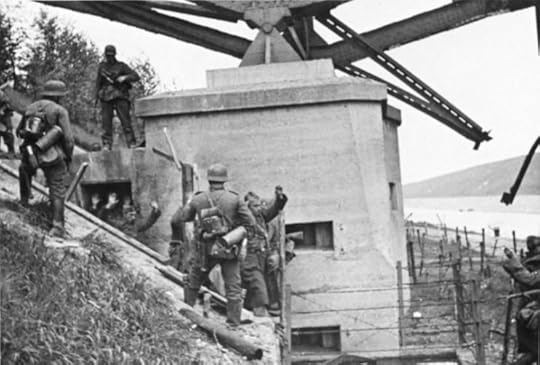
Belgian soldiers surrender to German paratroopers after the Battle of Fort Eben-Emael, 11 May 1940. Photo: Bundesarchiv, Bild 146-1974-061-017 / CC-BY-SA 3.0.
Link: https://youtu.be/eeRY6_Xdv30
This World War II German newsreel was retrieved from a U.S. Navy archive, and is now part of the Periscope Film collection. Made for propaganda purposes during the war by the German newsreel company Degeto Weltspiegel and sold to the home market in Germany, these newsreels provide a fascinating look at the German military. These German newsreels were seized by the U.S. government following the war, and ended up in the collection of the U.S. government.
The Battle of Belgium or Belgian Campaign, often referred to as the 18 Days' Campaign in Belgium, formed part of the greater Battle of France, an offensive campaign by Germany during the Second World War. It took place over 18 days in May 1940 and ended with the German occupation of Belgium following the surrender of the Belgian Army.
On 10 May 1940, Germany invaded Luxembourg, the Netherlands, and Belgium under the operational plan Fall Gelb (Case Yellow). The Allied armies attempted to halt the German Army in Belgium, believing it to be the main German thrust. After the French had fully committed the best of the Allied armies to Belgium between 10 and 12 May, the Germans enacted the second phase of their operation, a break-through, or sickle cut, through the Ardennes, and advanced toward the English Channel. The German Army (Heer) reached the Channel after five days, encircling the Allied armies. The Germans gradually reduced the pocket of Allied forces, forcing them back to the sea. The Belgian Army surrendered on 28 May 1940, ending the battle.
The Battle of Belgium included the first tank battle of the war, the Battle of Hannut. It was the largest tank battle in history up to that date but was later surpassed by the battles of the North African campaign and the Eastern Front. The battle also included the Battle of Fort Eben-Emael, the first strategic airborne operation using paratroopers ever attempted.
The German official history stated that in the 18 days of bitter fighting, the Belgian Army were tough opponents, and spoke of the "extraordinary bravery" of its soldiers. The Belgian collapse forced the Allied withdrawal from continental Europe. The British Royal Navy subsequently evacuated Belgian ports during Operation Dynamo, allowing the British Army to escape and continue military operations. France reached its own armistice with Germany in June 1940. Belgium was occupied by the Germans until the autumn of 1944, when it was liberated by the Western Allies.
This film is part of the Periscope Film LLC archive, one of the largest historic military, transportation, and aviation stock footage collections in the USA
Growing Up In Nazi-Occupied Belgium | Memoirs Of WWII #9
Nelly “Michette” Thirifays-Hiett was five years old when her homeland of Belgium was invaded by the German Army. Here you’ll hear her perspective on living under enemy occupation and what freedom means to her.
Link: https://youtu.be/mryAIO5JKos
Nazis Occupy Brussels - 1940 | Today In History | 17 May 18
On May 17, 1940, the Nazis occupied Brussels, Belgium, during World War II.
Link: https://youtu.be/zups47WWULQ
Source: Youtube, Memoirs of World War II, British Movietone

Belgian soldiers surrender to German paratroopers after the Battle of Fort Eben-Emael, 11 May 1940. Photo: Bundesarchiv, Bild 146-1974-061-017 / CC-BY-SA 3.0.
Link: https://youtu.be/eeRY6_Xdv30
This World War II German newsreel was retrieved from a U.S. Navy archive, and is now part of the Periscope Film collection. Made for propaganda purposes during the war by the German newsreel company Degeto Weltspiegel and sold to the home market in Germany, these newsreels provide a fascinating look at the German military. These German newsreels were seized by the U.S. government following the war, and ended up in the collection of the U.S. government.
The Battle of Belgium or Belgian Campaign, often referred to as the 18 Days' Campaign in Belgium, formed part of the greater Battle of France, an offensive campaign by Germany during the Second World War. It took place over 18 days in May 1940 and ended with the German occupation of Belgium following the surrender of the Belgian Army.
On 10 May 1940, Germany invaded Luxembourg, the Netherlands, and Belgium under the operational plan Fall Gelb (Case Yellow). The Allied armies attempted to halt the German Army in Belgium, believing it to be the main German thrust. After the French had fully committed the best of the Allied armies to Belgium between 10 and 12 May, the Germans enacted the second phase of their operation, a break-through, or sickle cut, through the Ardennes, and advanced toward the English Channel. The German Army (Heer) reached the Channel after five days, encircling the Allied armies. The Germans gradually reduced the pocket of Allied forces, forcing them back to the sea. The Belgian Army surrendered on 28 May 1940, ending the battle.
The Battle of Belgium included the first tank battle of the war, the Battle of Hannut. It was the largest tank battle in history up to that date but was later surpassed by the battles of the North African campaign and the Eastern Front. The battle also included the Battle of Fort Eben-Emael, the first strategic airborne operation using paratroopers ever attempted.
The German official history stated that in the 18 days of bitter fighting, the Belgian Army were tough opponents, and spoke of the "extraordinary bravery" of its soldiers. The Belgian collapse forced the Allied withdrawal from continental Europe. The British Royal Navy subsequently evacuated Belgian ports during Operation Dynamo, allowing the British Army to escape and continue military operations. France reached its own armistice with Germany in June 1940. Belgium was occupied by the Germans until the autumn of 1944, when it was liberated by the Western Allies.
This film is part of the Periscope Film LLC archive, one of the largest historic military, transportation, and aviation stock footage collections in the USA
Growing Up In Nazi-Occupied Belgium | Memoirs Of WWII #9
Nelly “Michette” Thirifays-Hiett was five years old when her homeland of Belgium was invaded by the German Army. Here you’ll hear her perspective on living under enemy occupation and what freedom means to her.
Link: https://youtu.be/mryAIO5JKos
Nazis Occupy Brussels - 1940 | Today In History | 17 May 18
On May 17, 1940, the Nazis occupied Brussels, Belgium, during World War II.
Link: https://youtu.be/zups47WWULQ
Source: Youtube, Memoirs of World War II, British Movietone
message 58:
by
Bentley, Group Founder, Leader, Chief
(last edited May 29, 2020 02:29AM)
(new)
-
rated it 4 stars
Luxembourg during World War II (1940 - 1945)
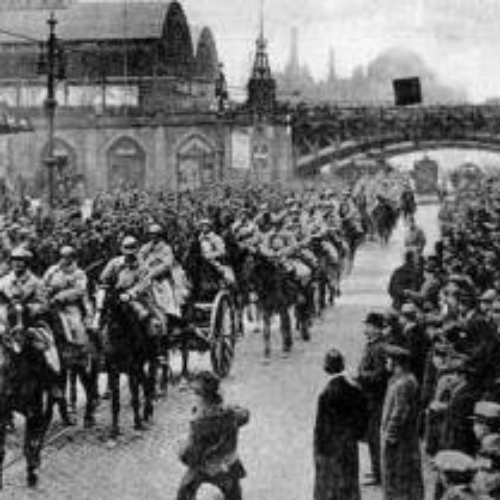
Link: https://youtu.be/nLKZUNmXMwE
Critical Past Video - Link: https://www.criticalpast.com/video/65...
Nazi leader Adolf Hitler's statement to maintain neutrality of Belgium, Holland and Luxembourg is presented on a slate. Then images of World War II German invasion of Belgium, Holland and Luxembourg are shown. German Luftwaffe planes drop bombs over cities in these countries. Aerial views of German planes over burning European cities. Ground level views of various buildings burning following Nazi bombings.
Invasion of Poland by World War II
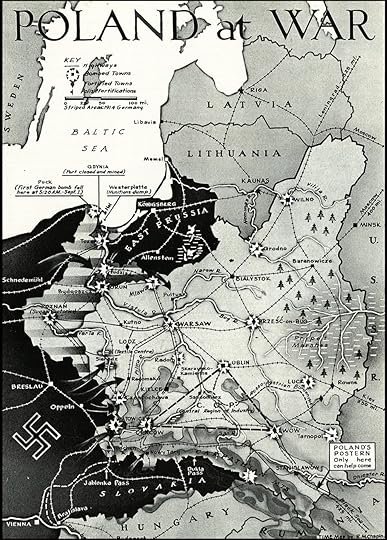
Eighty years this week, World War II began. “The telephone in Franklin Roosevelt’s bedroom at the White House rang at 2:50 a. m. on the first day of September,” the Sept. 11, 1939, issue of TIME explained. “In more ways than one it was a ghastly hour, but the operators knew they must ring.
Ambassador Bill Bullitt was calling from Paris. He had just been called by Ambassador Tony Biddle in Warsaw. Mr. Bullitt told Mr. Roosevelt that World War II had begun.
Adolf Hitler’s bombing planes were dropping death all over Poland.” On Sept. 3, the United Kingdom and France declared war.
Roosevelt wasn’t the only one expecting the dramatic news. In that same TIME issue, the first to hit stands after Germany began its march into Poland, the magazine provided readers with a timeline explaining the war’s start, despite a worldwide mood described as “thoroughly sick of and appalled by the idea of war.”
The retelling starts in March of 1939, after Hitler moved on Czechoslovakia, and continues throughout the spring as England and Germany deliberate over the future of Poland — but as late as Aug. 23, even after Germany surprised the world by announcing a non-aggression pact with the Soviet Union, war was not a foregone conclusion.
Remainder of article: (Here's how World War II began -Time)
https://time.com/3194657/world-war-ii...
Link: https://www.britannica.com/video/1802...
Source: Encyclopedia Britannica, Youtube, Time Magazine

Link: https://youtu.be/nLKZUNmXMwE
Critical Past Video - Link: https://www.criticalpast.com/video/65...
Nazi leader Adolf Hitler's statement to maintain neutrality of Belgium, Holland and Luxembourg is presented on a slate. Then images of World War II German invasion of Belgium, Holland and Luxembourg are shown. German Luftwaffe planes drop bombs over cities in these countries. Aerial views of German planes over burning European cities. Ground level views of various buildings burning following Nazi bombings.
Invasion of Poland by World War II

Eighty years this week, World War II began. “The telephone in Franklin Roosevelt’s bedroom at the White House rang at 2:50 a. m. on the first day of September,” the Sept. 11, 1939, issue of TIME explained. “In more ways than one it was a ghastly hour, but the operators knew they must ring.
Ambassador Bill Bullitt was calling from Paris. He had just been called by Ambassador Tony Biddle in Warsaw. Mr. Bullitt told Mr. Roosevelt that World War II had begun.
Adolf Hitler’s bombing planes were dropping death all over Poland.” On Sept. 3, the United Kingdom and France declared war.
Roosevelt wasn’t the only one expecting the dramatic news. In that same TIME issue, the first to hit stands after Germany began its march into Poland, the magazine provided readers with a timeline explaining the war’s start, despite a worldwide mood described as “thoroughly sick of and appalled by the idea of war.”
The retelling starts in March of 1939, after Hitler moved on Czechoslovakia, and continues throughout the spring as England and Germany deliberate over the future of Poland — but as late as Aug. 23, even after Germany surprised the world by announcing a non-aggression pact with the Soviet Union, war was not a foregone conclusion.
Remainder of article: (Here's how World War II began -Time)
https://time.com/3194657/world-war-ii...
Link: https://www.britannica.com/video/1802...
Source: Encyclopedia Britannica, Youtube, Time Magazine
message 59:
by
Bentley, Group Founder, Leader, Chief
(last edited May 29, 2020 02:21AM)
(new)
-
rated it 4 stars
Invasion of Belgium, Netherlands, Luxembourg and France
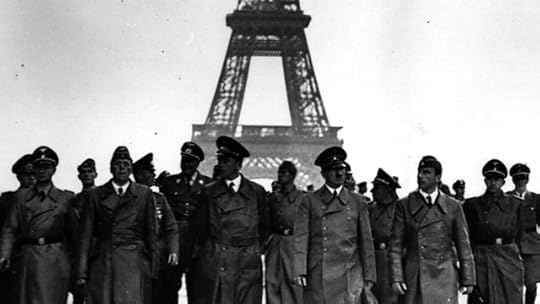
https://www.britannica.com/video/1802...
Source: Encyclopedia Britannica

https://www.britannica.com/video/1802...
Source: Encyclopedia Britannica
message 60:
by
Bentley, Group Founder, Leader, Chief
(last edited May 29, 2020 02:44AM)
(new)
-
rated it 4 stars
Normally our discussions begin on Sunday and run Sunday through Saturday each week. However, this buddy read began on a Monday and therefore runs each week from Monday through Sunday.
We will end the first week of reading and discussion on Sunday.
The following will be the Week Two assignment which starts on next Monday. It is never too late to jump in and join us.
Week Two - June 1st - June 7th - pages 24 - 48
Chapter 3: London and Washington - page 24
Chapter 4: Galvanized - page 27
Chapter 5: Moondread - page 39
We will end the first week of reading and discussion on Sunday.
The following will be the Week Two assignment which starts on next Monday. It is never too late to jump in and join us.
Week Two - June 1st - June 7th - pages 24 - 48
Chapter 3: London and Washington - page 24
Chapter 4: Galvanized - page 27
Chapter 5: Moondread - page 39
message 61:
by
Bentley, Group Founder, Leader, Chief
(last edited May 30, 2020 11:07PM)
(new)
-
rated it 4 stars
All, we have set up the backdrop of the book and the time frame above.
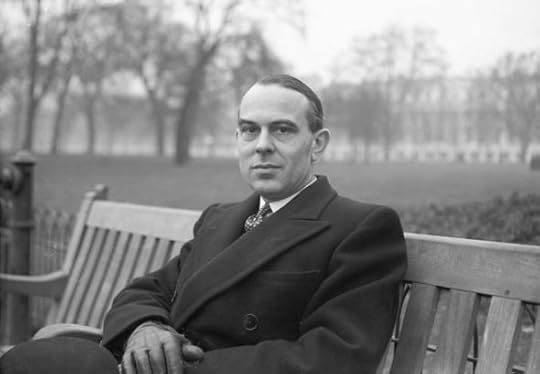
John Colville
Discussion Thoughts and Questions: (what do you think?)
1. Many do not realize that Stalin had made big plans with Hitler to divide the spoils and that did not turn out very well for Russia - with Russia ending up changing sides. Do you think that FDR and Churchill ever trusted Stalin because of that?
2. Why did Hitler invade neutral countries and then burn them or destroy them like flooding Holland? What was the purpose of conquering rubble and utter destruction? If the French knew that they had a weakness in the outskirts of the Ardennes - why didn't the French fortify this area? Obviously they suspected that Hitler might do an end run?
3. Why was Poland the last straw forcing France and England to declare war?
4. What were your impressions of Churchill's speech on July 14th, 1940 and how was it different from the speech Churchill gave on May 19th, 1940? How had the world changed?
5. How many of you have visited the Churchill Museum in London and have seen the actual underground bunkers where Churchill stayed? Or have visited Chartwell? What are your thoughts about Churchill as a Prime Minister and war time leader of England?
6. Listening to the very young Elizabeth giving her radio address shows you a very self assured young girl even then and what do you think was the purpose of the speech itself?

John Colville
Discussion Thoughts and Questions: (what do you think?)
1. Many do not realize that Stalin had made big plans with Hitler to divide the spoils and that did not turn out very well for Russia - with Russia ending up changing sides. Do you think that FDR and Churchill ever trusted Stalin because of that?
2. Why did Hitler invade neutral countries and then burn them or destroy them like flooding Holland? What was the purpose of conquering rubble and utter destruction? If the French knew that they had a weakness in the outskirts of the Ardennes - why didn't the French fortify this area? Obviously they suspected that Hitler might do an end run?
3. Why was Poland the last straw forcing France and England to declare war?
4. What were your impressions of Churchill's speech on July 14th, 1940 and how was it different from the speech Churchill gave on May 19th, 1940? How had the world changed?
5. How many of you have visited the Churchill Museum in London and have seen the actual underground bunkers where Churchill stayed? Or have visited Chartwell? What are your thoughts about Churchill as a Prime Minister and war time leader of England?
6. Listening to the very young Elizabeth giving her radio address shows you a very self assured young girl even then and what do you think was the purpose of the speech itself?
Some beginning Reading Guide questions to think about as you are reading:
1. The book’s title comes from a line in John Colville’s diary about the peculiar beauty of watching bombs fall over his home city: “Never was there such a contrast of natural splendor and human vileness.”
a) How do you think a tragedy like this could be considered beautiful?
b) Why do you think Larson chose this title?
2. The Splendid and the Vile covers Winston Churchill’s first year in office.
a) What are the benefits of focusing on this truncated time period?
 by John Colville (no photo)
by John Colville (no photo)
1. The book’s title comes from a line in John Colville’s diary about the peculiar beauty of watching bombs fall over his home city: “Never was there such a contrast of natural splendor and human vileness.”
a) How do you think a tragedy like this could be considered beautiful?
b) Why do you think Larson chose this title?
2. The Splendid and the Vile covers Winston Churchill’s first year in office.
a) What are the benefits of focusing on this truncated time period?
 by John Colville (no photo)
by John Colville (no photo)
We will still be working on this week's assignment through end of day on Sunday. Week Two begins on Monday.
message 64:
by
Bentley, Group Founder, Leader, Chief
(last edited May 29, 2020 08:57AM)
(new)
-
rated it 4 stars
Clementine Churchill:
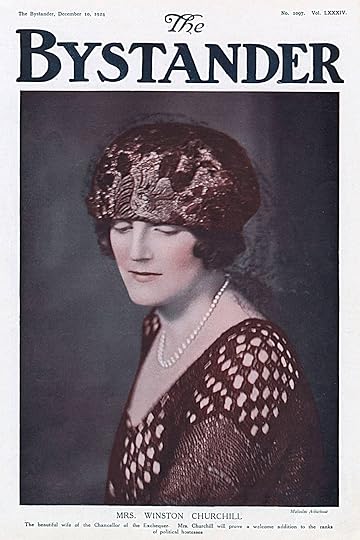
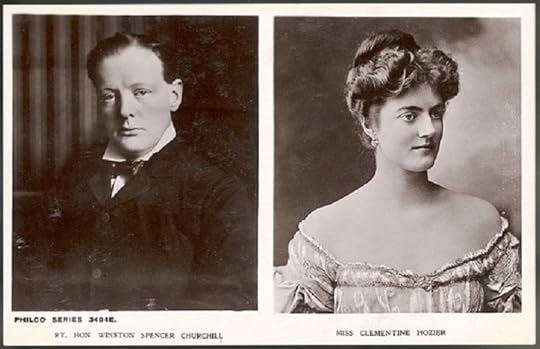
Clementine Ogilvy Spencer-Churchill, Baroness Spencer-Churchill, GBE (née Hozier; 1 April 1885 – 12 December 1977)[1] was the wife of Winston Churchill, Prime Minister of the United Kingdom, and a life peer in her own right.
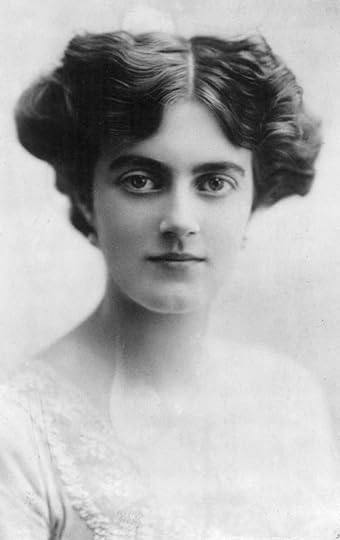
Remainder of article:
https://en.wikipedia.org/wiki/Clement...
Source: Wikipedia, International Churchill Society, CBC,
Tatler
Discussion Thoughts and Questions: (what did you think?)
1. In Chapter Two - A Night at the Savoy - what kind of woman was Clementine Churchill and how did she complement Winston? How was she every bit as formidable as Churchill?
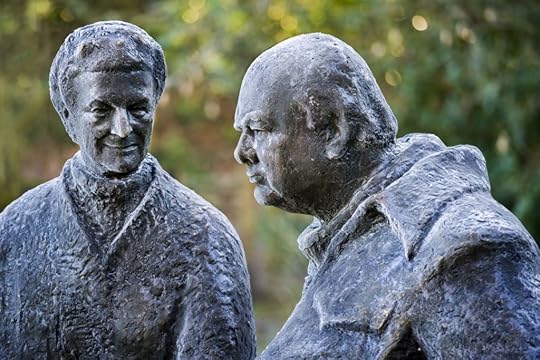
Clementine and Winston at Chartwell
More:
https://winstonchurchill.org/publicat...
Clementine and Eleanor: Two First Ladies of War
Video: https://winstonchurchill.org/news-and...
Edwina Sandys on Her Grandparents Winston and Clementine Churchill
Video: https://youtu.be/GJQt0Cl_lNA
Winston Churchill's daughter, 1979: CBC Archives | CBC regarding her mother
Video: https://youtu.be/xoCWHsLgAlw
The lady behind the bulldog - Clementine Churchill exhibition opens in Chartwell
Video: https://youtu.be/6A45qED1IRA
More:
 by Sonia Purnell (no photo)
by Sonia Purnell (no photo)
 by
by
 Mary Soames
Mary Soames
 by Sonia Purnell (no photo)
by Sonia Purnell (no photo)


Clementine Ogilvy Spencer-Churchill, Baroness Spencer-Churchill, GBE (née Hozier; 1 April 1885 – 12 December 1977)[1] was the wife of Winston Churchill, Prime Minister of the United Kingdom, and a life peer in her own right.

Remainder of article:
https://en.wikipedia.org/wiki/Clement...
Source: Wikipedia, International Churchill Society, CBC,
Tatler
Discussion Thoughts and Questions: (what did you think?)
1. In Chapter Two - A Night at the Savoy - what kind of woman was Clementine Churchill and how did she complement Winston? How was she every bit as formidable as Churchill?

Clementine and Winston at Chartwell
More:
https://winstonchurchill.org/publicat...
Clementine and Eleanor: Two First Ladies of War
Video: https://winstonchurchill.org/news-and...
Edwina Sandys on Her Grandparents Winston and Clementine Churchill
Video: https://youtu.be/GJQt0Cl_lNA
Winston Churchill's daughter, 1979: CBC Archives | CBC regarding her mother
Video: https://youtu.be/xoCWHsLgAlw
The lady behind the bulldog - Clementine Churchill exhibition opens in Chartwell
Video: https://youtu.be/6A45qED1IRA
More:
 by Sonia Purnell (no photo)
by Sonia Purnell (no photo) by
by
 Mary Soames
Mary Soames by Sonia Purnell (no photo)
by Sonia Purnell (no photo)
message 65:
by
Bentley, Group Founder, Leader, Chief
(last edited May 29, 2020 03:51PM)
(new)
-
rated it 4 stars
Mary Churchill
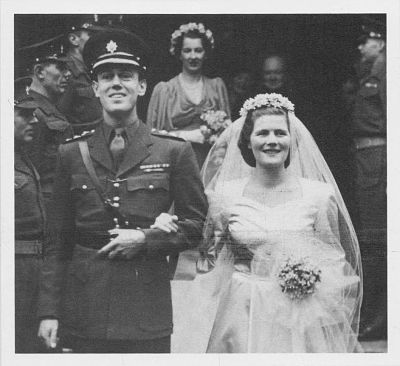
The wedding day of Christopher and Mary Soames, 1947

The Final Farewell: Family and Friends Gather to Remember Mary Soames - Finest Hour 166, Winter 2015 - Page 12
Link: https://winstonchurchill.org/publicat...
The Guardian Obituary:
Link: https://www.theguardian.com/books/201...
More:
 by
by
 Mary Soames
Mary Soames
 by
by
 Mary Soames
Mary Soames
 by
by
 Winston S. Churchill
Winston S. Churchill
Chapter 2 - A Night at the Savoy
MARY CHURCHILL, SEVENTEEN YEARS OLD, awoke that morning, May 10, to the grim news from Europe. The details were terrifying in themselves, but it was the juxtaposition between how Mary had spent her night and what had happened across the English Channel that made it all the more shocking.
Mary was the youngest of Churchill’s four children; a fifth child, a daughter named Marigold, the family’s beloved “Duckadilly,” had died of septicemia in August 1921, at two years and nine months of age.
Both parents were present at her death, a moment that drew from Clementine, as Churchill later told Mary, “a succession of wild shrieks, like an animal in mortal pain.”
Mary’s eldest sister, Diana, thirty, was married to Duncan Sandys (pronounced Sands), who served as Churchill’s “special liaison” to Air Raid Precautions (ARP), the civil defense division
division of the Home Office. They had three children. The second sister, Sarah, twenty-five, so stubborn that as a child she was nicknamed “Mule,” was an actress who, to Churchill’s displeasure, had married an Austrian entertainer named Vic Oliver, sixteen years her senior and twice married before he met her. They had no children. The fourth child was Randolph, nearly twenty-nine, who a year earlier had married Pamela Digby, now twenty years old and pregnant with their first child. Mary was pretty, buoyant, and spirited, described by one observer as “very effervescent.” She approached the world with the unabashed enthusiasm of a spring lamb, a guilelessness that a young American visitor, Kathy Harriman, found cloying. “She’s a very intelligent girl,” Harriman wrote, “but so naive that it hurts. She says such frank things; then people laugh at her, make fun of her, and being super-sensitive, she takes it all to heart.” At her birth, Mary’s mother, Clementine had nicknamed her "Mary the mouse."
Source: Larson, Erik. The Splendid and the Vile (p. 17). Crown. Kindle Edition.
Discussion Thoughts and Questions (what do you think?)
1. What were your thoughts about Mary Churchill and how she was described by the author? I wondered why at her birth - she had been nicknamed - Mary the mouse? Curious nickname for a baby at birth?
2. What were your thoughts regarding Mary's view of John "Jock" Colville - the assistant private secretary to Neville Chamberlain who had just been reassigned to Churchill - “I suspected him—rightly, on both counts!—of being a ‘Chamberlainite’ and a ‘Municheer.’ ” He, in turn, was less than enthralled with her: “I thought the Churchill girl rather supercilious.”
Source: Larson, Erik. The Splendid and the Vile (p. 20). Crown. Kindle Edition.

The wedding day of Christopher and Mary Soames, 1947

The Final Farewell: Family and Friends Gather to Remember Mary Soames - Finest Hour 166, Winter 2015 - Page 12
Link: https://winstonchurchill.org/publicat...
The Guardian Obituary:
Link: https://www.theguardian.com/books/201...
More:
 by
by
 Mary Soames
Mary Soames by
by
 Mary Soames
Mary Soames by
by
 Winston S. Churchill
Winston S. ChurchillChapter 2 - A Night at the Savoy
MARY CHURCHILL, SEVENTEEN YEARS OLD, awoke that morning, May 10, to the grim news from Europe. The details were terrifying in themselves, but it was the juxtaposition between how Mary had spent her night and what had happened across the English Channel that made it all the more shocking.
Mary was the youngest of Churchill’s four children; a fifth child, a daughter named Marigold, the family’s beloved “Duckadilly,” had died of septicemia in August 1921, at two years and nine months of age.
Both parents were present at her death, a moment that drew from Clementine, as Churchill later told Mary, “a succession of wild shrieks, like an animal in mortal pain.”
Mary’s eldest sister, Diana, thirty, was married to Duncan Sandys (pronounced Sands), who served as Churchill’s “special liaison” to Air Raid Precautions (ARP), the civil defense division
division of the Home Office. They had three children. The second sister, Sarah, twenty-five, so stubborn that as a child she was nicknamed “Mule,” was an actress who, to Churchill’s displeasure, had married an Austrian entertainer named Vic Oliver, sixteen years her senior and twice married before he met her. They had no children. The fourth child was Randolph, nearly twenty-nine, who a year earlier had married Pamela Digby, now twenty years old and pregnant with their first child. Mary was pretty, buoyant, and spirited, described by one observer as “very effervescent.” She approached the world with the unabashed enthusiasm of a spring lamb, a guilelessness that a young American visitor, Kathy Harriman, found cloying. “She’s a very intelligent girl,” Harriman wrote, “but so naive that it hurts. She says such frank things; then people laugh at her, make fun of her, and being super-sensitive, she takes it all to heart.” At her birth, Mary’s mother, Clementine had nicknamed her "Mary the mouse."
Source: Larson, Erik. The Splendid and the Vile (p. 17). Crown. Kindle Edition.
Discussion Thoughts and Questions (what do you think?)
1. What were your thoughts about Mary Churchill and how she was described by the author? I wondered why at her birth - she had been nicknamed - Mary the mouse? Curious nickname for a baby at birth?
2. What were your thoughts regarding Mary's view of John "Jock" Colville - the assistant private secretary to Neville Chamberlain who had just been reassigned to Churchill - “I suspected him—rightly, on both counts!—of being a ‘Chamberlainite’ and a ‘Municheer.’ ” He, in turn, was less than enthralled with her: “I thought the Churchill girl rather supercilious.”
Source: Larson, Erik. The Splendid and the Vile (p. 20). Crown. Kindle Edition.
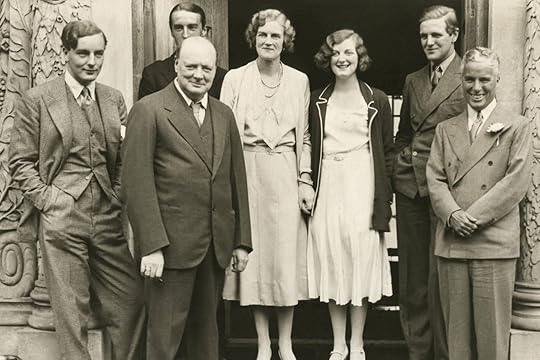
Tom Mitford, Winston Churchill, Freddie Birkenhead, Clemmie Churchill, Diana Churchill, Randolph Churchill and Charlie Chaplin in Sept 1932.
message 67:
by
Bentley, Group Founder, Leader, Chief
(last edited May 29, 2020 09:29AM)
(new)
-
rated it 4 stars
Diana Churchill
Diana Spencer-Churchill (11 July 1909 – 20 October 1963) was the eldest daughter of British statesman Sir Winston Churchill and Clementine Churchill, Baroness Spencer-Churchill (née Hozier).
Remainder of article;
https://en.wikipedia.org/wiki/Diana_C...

Diana Sandys, née Churchill
Link: https://www.nationaltrust.org.uk/char...
Source: National Trust, Wikipedia, British Pathe, Youtube
More:
https://winstonchurchill.org/tag/dian...
The Churchill Wedding (1932)
Full title reads: "London. The Churchill Wedding. 'All the world and his wife' crowd to see 'Winston's' lovely daughter, Diana, married to Mr J Bailey." - London.
Video: https://youtu.be/HeDMHF9ybJA
Diana Churchill, in her wedding dress, and Winston Churchill, smoking his traditional cigar, come out of the doorway of their London home. A large number of photographers are there to capture the image. A car draws up and Winston and Diana get in.
At the Church (possibly St. Margaret's, Parliament Square) Diana gets out of the car very quickly, while Winston takes his time and removes his overcoat.
Exterior shots of the Church. Crowds have gathered to see the wedding. As the bride and groom come out of the Church the crowds move forwards and have to be held back by the police.
The bridal party come past the camera. Sarah Churchill is one of the bridesmaids. Clementine Churchill is walking with the groom's father. Winston is with the groom's mother. Also in the group is a young looking Randolph Churchill.
Good shots of the excited looking crowd watching Diana and her husband, John Bailey. Once again lots of photographers and cameramen are in evidence. The happy couple make their way to the car.
Wedding guests have to make their way through the crowd. Racing tipster Prince Monalulu is pointing out guests. Amongst the guests is David Lloyd George.
Sound Track Missing. Mute Print in tin. NB. Diana later married politician Duncan Sandys. FILM ID:691.11 - A VIDEO FROM BRITISH PATHÉ.
Diana Spencer-Churchill (11 July 1909 – 20 October 1963) was the eldest daughter of British statesman Sir Winston Churchill and Clementine Churchill, Baroness Spencer-Churchill (née Hozier).
Remainder of article;
https://en.wikipedia.org/wiki/Diana_C...

Diana Sandys, née Churchill
Link: https://www.nationaltrust.org.uk/char...
Source: National Trust, Wikipedia, British Pathe, Youtube
More:
https://winstonchurchill.org/tag/dian...
The Churchill Wedding (1932)
Full title reads: "London. The Churchill Wedding. 'All the world and his wife' crowd to see 'Winston's' lovely daughter, Diana, married to Mr J Bailey." - London.
Video: https://youtu.be/HeDMHF9ybJA
Diana Churchill, in her wedding dress, and Winston Churchill, smoking his traditional cigar, come out of the doorway of their London home. A large number of photographers are there to capture the image. A car draws up and Winston and Diana get in.
At the Church (possibly St. Margaret's, Parliament Square) Diana gets out of the car very quickly, while Winston takes his time and removes his overcoat.
Exterior shots of the Church. Crowds have gathered to see the wedding. As the bride and groom come out of the Church the crowds move forwards and have to be held back by the police.
The bridal party come past the camera. Sarah Churchill is one of the bridesmaids. Clementine Churchill is walking with the groom's father. Winston is with the groom's mother. Also in the group is a young looking Randolph Churchill.
Good shots of the excited looking crowd watching Diana and her husband, John Bailey. Once again lots of photographers and cameramen are in evidence. The happy couple make their way to the car.
Wedding guests have to make their way through the crowd. Racing tipster Prince Monalulu is pointing out guests. Amongst the guests is David Lloyd George.
Sound Track Missing. Mute Print in tin. NB. Diana later married politician Duncan Sandys. FILM ID:691.11 - A VIDEO FROM BRITISH PATHÉ.
message 68:
by
Bentley, Group Founder, Leader, Chief
(last edited May 29, 2020 04:06PM)
(new)
-
rated it 4 stars
Randolph Churchill
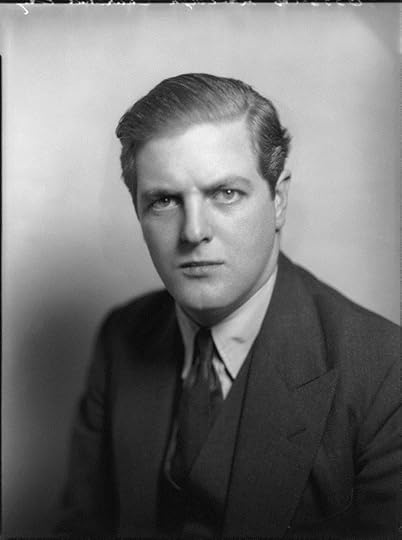
Randolph Churchill in 1935. By Bassano Ltd. (whole-plate film negative, 1935). © National Portrait Gallery, London
Randolph perhaps epitomises the difficulty of being the son of a famous father.
In his twenties, he veered between adoration of his father and bitter accusations of being treated as a ‘wayward and untrustworthy child’, interspersed with periods of excess drinking and ill-considered political initiatives.
Randolph duly stood for parliament in the 1930s but despite the obvious advantage of his father’s support, he was defeated each time, being seen – in true Churchill style – as a political maverick. He was elected as MP for Preston in 1940 but lost his seat at the 1945 General Election.
While he had his father’s weaknesses (notably, obstinacy, arrogance and bad temper), he did also inherit some of his strengths, including a gift for writing and considerable personal bravery, serving with the newly formed Special Air Service (SAS) and conducting dangerous missions in the Libyan Desert and Yugoslavia. Yet, ultimately, he lacked his father’s political skills, charm and charisma.
Churchill no doubt loved his son, but sometimes despaired of him. Their strong personalities would often clash.
Their father–son love–hate relationship was never entirely resolved, although there was seemingly a reconciliation in later life when Churchill approved Randolph’s appointment as his official biographer in the early 1960s.
And it’s clear that, despite their lifelong differences, Randolph never stopped worshipping his father, just as Churchill had worshipped his father a generation earlier.
Randolph married twice, first to Pamela Digby (later Harriman) in 1939, with whom he had a son, Winston, and then to June Osborne in the late 1940s, with whom he had a daughter, Arabella. Neither marriage was a success. He went on to carve out a name for himself as a gossip columnist and writer, but died in 1968 without having fulfilled his father’s expectations – and before he could complete his father’s biography (though he did see the first two volumes published).
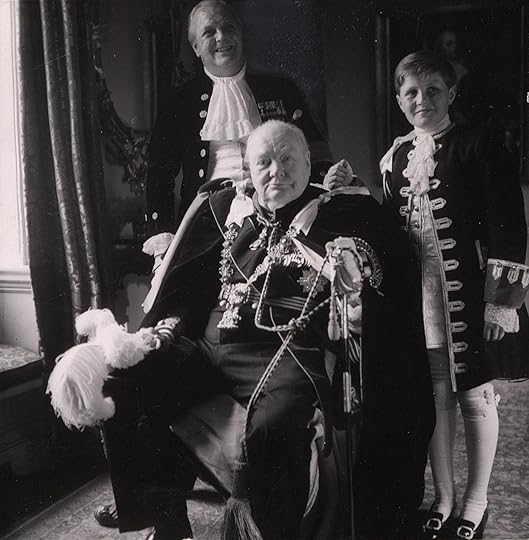
Photograph shows Winston Churchill, full-length portrait, seated, facing front, with his son and grandson standing behind him, wearing coronation robes.
Source: International Churchill Society, British Pathe, Wikipedia
More:
https://en.wikipedia.org/wiki/Randolp...
Churchill's Son In Israel (1955)
Video: https://youtu.be/M-4e7Rg_mX8
RANDOLPH CHURCHILL TALKS TO AMERICA - SOUND
Video: https://youtu.be/vuy0zCfX6Q8
First Lord's Son Marries (Pamela Digby)
https://youtu.be/V3ggwVImtT8
Biography Of Winston (1963)
https://youtu.be/kmRwHYfwQ_s
https://youtu.be/V3ggwVImtT8
Uncovering Great Minds by Thomas Maier
Winston Churchill’s Brilliant but Troubled Son, Randolph
Was he bipolar? Evidence suggests Randolph suffered behavioral ills
Link: https://www.psychologytoday.com/us/bl...
 by Randolph S. Churchill (no photo)
by Randolph S. Churchill (no photo)
IN THE MIDST OF THIS, Churchill had to cope with all manner of other challenges. An immense personal debt payment was due at the end of the month, one he did not have the money to pay.
His only son, Randolph, likewise was awash in debt, persistently demonstrating a gift not just for spending money but also for losing it gambling, at which his ineptitude was legendary; he also drank too much and had a propensity, once drunk, for making scenes and thereby posing what his mother, Clementine (pronounced Clementeen), saw as a continual risk that one day he would cause irrevocable embarrassment to the family.
Churchill also had to deal with blackout rules and strict rationing and the mounting intrusion of officials seeking to keep him safe from assassination—as well as, not least, the everlasting offense of the army of workmen dispatched to buttress 10 Downing Street and the rest of Whitehall against aerial attack, with their endless hammering, which more than any other single irritant had the capacity to drive him to the point of fury.
Source: Larson, Erik. The Splendid and the Vile (p. 15). Crown. Kindle Edition.
Discussion Thoughts and Questions (what do you think?)
1. What were your thoughts about Randolph after reading the above and do you feel that author was fair to Randolph to offer such a description?

Randolph Churchill in 1935. By Bassano Ltd. (whole-plate film negative, 1935). © National Portrait Gallery, London
Randolph perhaps epitomises the difficulty of being the son of a famous father.
In his twenties, he veered between adoration of his father and bitter accusations of being treated as a ‘wayward and untrustworthy child’, interspersed with periods of excess drinking and ill-considered political initiatives.
Randolph duly stood for parliament in the 1930s but despite the obvious advantage of his father’s support, he was defeated each time, being seen – in true Churchill style – as a political maverick. He was elected as MP for Preston in 1940 but lost his seat at the 1945 General Election.
While he had his father’s weaknesses (notably, obstinacy, arrogance and bad temper), he did also inherit some of his strengths, including a gift for writing and considerable personal bravery, serving with the newly formed Special Air Service (SAS) and conducting dangerous missions in the Libyan Desert and Yugoslavia. Yet, ultimately, he lacked his father’s political skills, charm and charisma.
Churchill no doubt loved his son, but sometimes despaired of him. Their strong personalities would often clash.
Their father–son love–hate relationship was never entirely resolved, although there was seemingly a reconciliation in later life when Churchill approved Randolph’s appointment as his official biographer in the early 1960s.
And it’s clear that, despite their lifelong differences, Randolph never stopped worshipping his father, just as Churchill had worshipped his father a generation earlier.
Randolph married twice, first to Pamela Digby (later Harriman) in 1939, with whom he had a son, Winston, and then to June Osborne in the late 1940s, with whom he had a daughter, Arabella. Neither marriage was a success. He went on to carve out a name for himself as a gossip columnist and writer, but died in 1968 without having fulfilled his father’s expectations – and before he could complete his father’s biography (though he did see the first two volumes published).

Photograph shows Winston Churchill, full-length portrait, seated, facing front, with his son and grandson standing behind him, wearing coronation robes.
Source: International Churchill Society, British Pathe, Wikipedia
More:
https://en.wikipedia.org/wiki/Randolp...
Churchill's Son In Israel (1955)
Video: https://youtu.be/M-4e7Rg_mX8
RANDOLPH CHURCHILL TALKS TO AMERICA - SOUND
Video: https://youtu.be/vuy0zCfX6Q8
First Lord's Son Marries (Pamela Digby)
https://youtu.be/V3ggwVImtT8
Biography Of Winston (1963)
https://youtu.be/kmRwHYfwQ_s
https://youtu.be/V3ggwVImtT8
Uncovering Great Minds by Thomas Maier
Winston Churchill’s Brilliant but Troubled Son, Randolph
Was he bipolar? Evidence suggests Randolph suffered behavioral ills
Link: https://www.psychologytoday.com/us/bl...
 by Randolph S. Churchill (no photo)
by Randolph S. Churchill (no photo)IN THE MIDST OF THIS, Churchill had to cope with all manner of other challenges. An immense personal debt payment was due at the end of the month, one he did not have the money to pay.
His only son, Randolph, likewise was awash in debt, persistently demonstrating a gift not just for spending money but also for losing it gambling, at which his ineptitude was legendary; he also drank too much and had a propensity, once drunk, for making scenes and thereby posing what his mother, Clementine (pronounced Clementeen), saw as a continual risk that one day he would cause irrevocable embarrassment to the family.
Churchill also had to deal with blackout rules and strict rationing and the mounting intrusion of officials seeking to keep him safe from assassination—as well as, not least, the everlasting offense of the army of workmen dispatched to buttress 10 Downing Street and the rest of Whitehall against aerial attack, with their endless hammering, which more than any other single irritant had the capacity to drive him to the point of fury.
Source: Larson, Erik. The Splendid and the Vile (p. 15). Crown. Kindle Edition.
Discussion Thoughts and Questions (what do you think?)
1. What were your thoughts about Randolph after reading the above and do you feel that author was fair to Randolph to offer such a description?
message 69:
by
Bentley, Group Founder, Leader, Chief
(last edited May 29, 2020 02:45PM)
(new)
-
rated it 4 stars
Chartwell
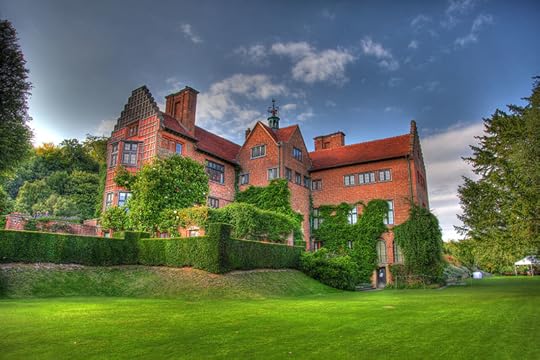
The House He Loved (1966)
MS of Mountbatten talks about Chartwell
Video: https://youtu.be/ZsTyrS1eUtE
More:
https://winstonchurchill.org/visit/ch...
A Walk Around Chartwell, Kent, England
https://youtu.be/P-r-rqonjSg
Chartwell was the principal adult home of Sir Winston Churchill. Churchill and his wife Clementine bought the property, located two miles south of Westerham, Kent, England, in 1922. Extensive renovations simplifying and modernising the home were undertaken directly, completely transforming it when complete.
When it became clear to the Churchills in 1946 that they could not afford to run the property, a consortium of wealthy businessmen organised by Lord Camrose purchased the estate. The arrangement was that for payment of nominal rent both Sir Winston and Lady Churchill would have the right to live there until they both died, at which point the property would be presented to the National Trust. When Sir Winston died in 1965, Clementine decided to present Chartwell to the National Trust immediately.
The house has been preserved as it would have looked when Churchill owned it. Rooms are carefully decorated with memorabilia and gifts, the original furniture and books, as well as honours and medals that Churchill received. The house is Grade I listed for historical reasons. The gardens are listed Grade II.
The property is currently under the administration of the National Trust. Chartwell was bought by a group of Churchill's friends in 1946, with the Churchills paying a nominal rent, but was not open to the public until it was presented to the nation in 1966, one year after Churchill's death.
Sources: British Pathe, Chartwell, Westerham, Kent, Youtube, National Trust

The House He Loved (1966)
MS of Mountbatten talks about Chartwell
Video: https://youtu.be/ZsTyrS1eUtE
More:
https://winstonchurchill.org/visit/ch...
A Walk Around Chartwell, Kent, England
https://youtu.be/P-r-rqonjSg
Chartwell was the principal adult home of Sir Winston Churchill. Churchill and his wife Clementine bought the property, located two miles south of Westerham, Kent, England, in 1922. Extensive renovations simplifying and modernising the home were undertaken directly, completely transforming it when complete.
When it became clear to the Churchills in 1946 that they could not afford to run the property, a consortium of wealthy businessmen organised by Lord Camrose purchased the estate. The arrangement was that for payment of nominal rent both Sir Winston and Lady Churchill would have the right to live there until they both died, at which point the property would be presented to the National Trust. When Sir Winston died in 1965, Clementine decided to present Chartwell to the National Trust immediately.
The house has been preserved as it would have looked when Churchill owned it. Rooms are carefully decorated with memorabilia and gifts, the original furniture and books, as well as honours and medals that Churchill received. The house is Grade I listed for historical reasons. The gardens are listed Grade II.
The property is currently under the administration of the National Trust. Chartwell was bought by a group of Churchill's friends in 1946, with the Churchills paying a nominal rent, but was not open to the public until it was presented to the nation in 1966, one year after Churchill's death.
Sources: British Pathe, Chartwell, Westerham, Kent, Youtube, National Trust
message 70:
by
Bentley, Group Founder, Leader, Chief
(last edited May 29, 2020 03:13PM)
(new)
-
rated it 4 stars
Sarah Churchill
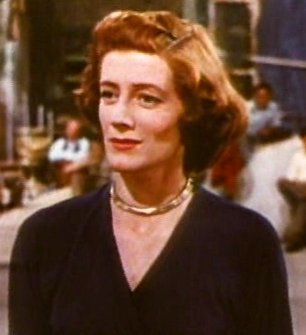
Sarah Churchill in Royal Wedding

Winston Churchill visiting the his old regiment during the Cairo Conference, Egypt, wearing the uniform of a colonel of the 4th Queen's Own Hussars. He is accompanied by his daughter Sarah Churchill and Lieutenant General Stone. The regimental flag flies above. Winston Churchill is accompanied by his daughter Sarah, Cairo, December 1943 - Imperial War Museum
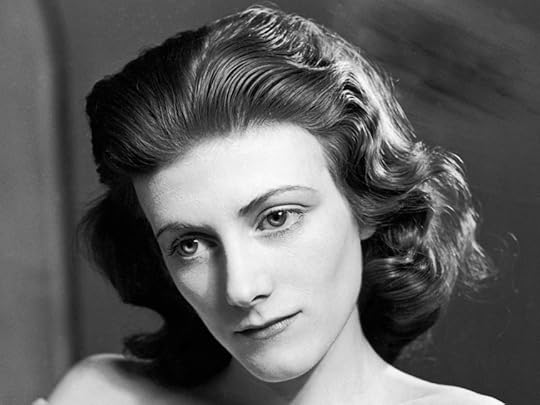
Sarah Millicent Hermione Touchet-Jesson, Baroness Audley (née Spencer-Churchill; 7 October 1914 – 24 September 1982) was a British actress and dancer known for being the daughter of Winston Churchill, who was Prime Minister from 1940 to 1945 and from 1951 to 1955.
Remainder of article:
https://en.wikipedia.org/wiki/Randolp...
The Favorite and the Actress: The Two Sarah Churchills
Video: https://www.churchillcentral.com/sara...
SARAH CHURCHILL WEDS
Mr Anthony Beauchamp, British Society photographer, recently married Miss Sarah Churchill, the actress daughter of Winston. They face the cameras in New York to talk about their wedding which took place in Georgia.
Video: https://youtu.be/Tu8cjP-njY8
Sarah Churchill presents Portrait of London (1956)
Portrait of London
Recorded and presented by Sarah Churchill
https://youtu.be/avJy1ajp-bw
A lion gift to her father was mentioned - https://www.mynewsmag.co.uk/footage-o...
SARAH CHURCHILL INTERVIEWS LORD WOOLTON
Video: https://youtu.be/Pd-ssgAaHB8
Source: Wikipedia, Churchill Central, Youtube, CBS Radio Workshop - The Theatre of the Mind.

Sarah Churchill in Royal Wedding

Winston Churchill visiting the his old regiment during the Cairo Conference, Egypt, wearing the uniform of a colonel of the 4th Queen's Own Hussars. He is accompanied by his daughter Sarah Churchill and Lieutenant General Stone. The regimental flag flies above. Winston Churchill is accompanied by his daughter Sarah, Cairo, December 1943 - Imperial War Museum

Sarah Millicent Hermione Touchet-Jesson, Baroness Audley (née Spencer-Churchill; 7 October 1914 – 24 September 1982) was a British actress and dancer known for being the daughter of Winston Churchill, who was Prime Minister from 1940 to 1945 and from 1951 to 1955.
Remainder of article:
https://en.wikipedia.org/wiki/Randolp...
The Favorite and the Actress: The Two Sarah Churchills
Video: https://www.churchillcentral.com/sara...
SARAH CHURCHILL WEDS
Mr Anthony Beauchamp, British Society photographer, recently married Miss Sarah Churchill, the actress daughter of Winston. They face the cameras in New York to talk about their wedding which took place in Georgia.
Video: https://youtu.be/Tu8cjP-njY8
Sarah Churchill presents Portrait of London (1956)
Portrait of London
Recorded and presented by Sarah Churchill
https://youtu.be/avJy1ajp-bw
A lion gift to her father was mentioned - https://www.mynewsmag.co.uk/footage-o...
SARAH CHURCHILL INTERVIEWS LORD WOOLTON
Video: https://youtu.be/Pd-ssgAaHB8
Source: Wikipedia, Churchill Central, Youtube, CBS Radio Workshop - The Theatre of the Mind.
message 71:
by
Bentley, Group Founder, Leader, Chief
(last edited May 29, 2020 03:31PM)
(new)
-
rated it 4 stars
Marygold Frances Churchill

Marigold died from septicaemia during a holiday to Broadstairs with her French nanny. She had been unwell for six months and a cough appears to have developed first into a bacterial infection and then septicaemia. Her parents rushed to her bedside, arriving shortly before her death.

Clementine Churchill and Marigold who died at a little over two years old.
The Younger Daughters
THE CHURCHILLS NEVER GOT OVER THE DEATH OF LITTLE MARYGOLD
Sarah (born in October 1914 in the first months of the First World War) and Marigold (born just after the end of the War, in November 1918) were Churchill’s younger daughters. Life for them was to prove troubled and, in the case of Marigold, sadly very brief.
‘Many years later my father told me that when Marigold died, Clementine gave a succession of wild shrieks like an animal in mortal pain. My mother never got over Marigold’s death.’
- Mary Soames, Prelude to A Daughter’s Tale
Work-Life Balance and the Death of Winston Churchill’s Daughter
by Bill Murphy Jr. December 1, 2014 Updated August 19, 2015
Link: https://www.scarymommy.com/work-life-...
Source: Youtube, Scarry Mommy

Marigold died from septicaemia during a holiday to Broadstairs with her French nanny. She had been unwell for six months and a cough appears to have developed first into a bacterial infection and then septicaemia. Her parents rushed to her bedside, arriving shortly before her death.

Clementine Churchill and Marigold who died at a little over two years old.
The Younger Daughters
THE CHURCHILLS NEVER GOT OVER THE DEATH OF LITTLE MARYGOLD
Sarah (born in October 1914 in the first months of the First World War) and Marigold (born just after the end of the War, in November 1918) were Churchill’s younger daughters. Life for them was to prove troubled and, in the case of Marigold, sadly very brief.
‘Many years later my father told me that when Marigold died, Clementine gave a succession of wild shrieks like an animal in mortal pain. My mother never got over Marigold’s death.’
- Mary Soames, Prelude to A Daughter’s Tale
Work-Life Balance and the Death of Winston Churchill’s Daughter
by Bill Murphy Jr. December 1, 2014 Updated August 19, 2015
Link: https://www.scarymommy.com/work-life-...
Source: Youtube, Scarry Mommy
message 72:
by
Bentley, Group Founder, Leader, Chief
(last edited May 29, 2020 04:21PM)
(new)
-
rated it 4 stars
I would like to "circle back" to a few quotes from the earlier chapter which stood out for me and I wanted to make sure to add them to our discussion before concluding my entries for both Chapters One and Two:
1. "Coveting power for power’s sake was a “base” pursuit, he wrote, adding, “But power in a national crisis, when a man believes he knows what orders should be given, is a blessing.”
Source: Larson, Erik. The Splendid and the Vile (p. 14). Crown. Kindle Edition.
2. From the very start, Churchill understood a fundamental truth about the war: that he could not win it without the eventual participation of the United States. Left to itself, he believed, Britain could endure and hold Germany at bay, but only the industrial might and manpower of America would ensure the final eradication of Hitler and National Socialism.
Source: Larson, Erik. The Splendid and the Vile (p. 15). Crown. Kindle Edition.
3. "But one of Churchill’s great strengths was perspective, which gave him the ability to place discrete events into boxes, so that bad humor could in a heartbeat turn to mirth."
Source: Larson, Erik. The Splendid and the Vile (p. 16). Crown. Kindle Edition.
Discussion Thoughts and Questions: (what do you think?)
1. Did any of the above quotes make an impression upon you while reading them? Did Churchill covet power or did he feel that he was the best person for the job of prime minister?
2. If the US was Britain's only hope of winning the war rather than keeping the wolves at bay (which was true at the time), why do you think that current generations try to undervalue that key assistance and that importance?
3. What was Churchill really like and how was he able to compartmentalize life so that he could handle whatever was thrown his way?
4. A final question regarding your thoughts on what the king wrote:
The king wrote, “I sent for Winston & asked him to form a Government. This he accepted & told me he had not thought this was the reason for my having sent for him”—though Churchill, according to the king’s account, did happen to have handy the names of a few men he was considering for his own cabinet. I had to chuckle at this account and ever Winston - be prepared (I guess) was always his motto (lol).
Source: Larson, Erik. The Splendid and the Vile (p. 13). Crown. Kindle Edition.
1. "Coveting power for power’s sake was a “base” pursuit, he wrote, adding, “But power in a national crisis, when a man believes he knows what orders should be given, is a blessing.”
Source: Larson, Erik. The Splendid and the Vile (p. 14). Crown. Kindle Edition.
2. From the very start, Churchill understood a fundamental truth about the war: that he could not win it without the eventual participation of the United States. Left to itself, he believed, Britain could endure and hold Germany at bay, but only the industrial might and manpower of America would ensure the final eradication of Hitler and National Socialism.
Source: Larson, Erik. The Splendid and the Vile (p. 15). Crown. Kindle Edition.
3. "But one of Churchill’s great strengths was perspective, which gave him the ability to place discrete events into boxes, so that bad humor could in a heartbeat turn to mirth."
Source: Larson, Erik. The Splendid and the Vile (p. 16). Crown. Kindle Edition.
Discussion Thoughts and Questions: (what do you think?)
1. Did any of the above quotes make an impression upon you while reading them? Did Churchill covet power or did he feel that he was the best person for the job of prime minister?
2. If the US was Britain's only hope of winning the war rather than keeping the wolves at bay (which was true at the time), why do you think that current generations try to undervalue that key assistance and that importance?
3. What was Churchill really like and how was he able to compartmentalize life so that he could handle whatever was thrown his way?
4. A final question regarding your thoughts on what the king wrote:
The king wrote, “I sent for Winston & asked him to form a Government. This he accepted & told me he had not thought this was the reason for my having sent for him”—though Churchill, according to the king’s account, did happen to have handy the names of a few men he was considering for his own cabinet. I had to chuckle at this account and ever Winston - be prepared (I guess) was always his motto (lol).
Source: Larson, Erik. The Splendid and the Vile (p. 13). Crown. Kindle Edition.
message 73:
by
Bentley, Group Founder, Leader, Chief
(last edited May 29, 2020 04:29PM)
(new)
-
rated it 4 stars
We began to cover some of the reading guide questions and now after reading Chapters One and Two in addition to the other preliminary segments - I would like to add and introduce another couple of questions to discuss with all of you (please post your comments):
Some beginning Reading Guide questions to think about as you are reading:
1. The book’s title comes from a line in John Colville’s diary about the peculiar beauty of watching bombs fall over his home city: “Never was there such a contrast of natural splendor and human vileness.”
a) How do you think a tragedy like this could be considered beautiful?
b) Why do you think Larson chose this title?
2. The Splendid and the Vile covers Winston Churchill’s first year in office.
a) What are the benefits of focusing on this truncated time period?
3. Larson draws on many sources to provide a vivid picture of Churchill’s home and family life in his first year as prime minister. What struck you most about his family dynamic? Considering how powerful he was at the time, was his relationship with his family what you would have expected it to be? Why or why not?
4. Churchill’s most trusted advisers spent many long days and nights with the prime minister, so much so that they became like members of his family. Why do you think Churchill had such close relationships with his political advisers? What do you see as being the key advantages and disadvantages of running a government office in this way? Which of Churchill’s political relationships was the most interesting to you? These particular questions we can continually ponder as we read this book as I add others from the reading guide that are pertinent to the future chapters that we read.
Some beginning Reading Guide questions to think about as you are reading:
1. The book’s title comes from a line in John Colville’s diary about the peculiar beauty of watching bombs fall over his home city: “Never was there such a contrast of natural splendor and human vileness.”
a) How do you think a tragedy like this could be considered beautiful?
b) Why do you think Larson chose this title?
2. The Splendid and the Vile covers Winston Churchill’s first year in office.
a) What are the benefits of focusing on this truncated time period?
3. Larson draws on many sources to provide a vivid picture of Churchill’s home and family life in his first year as prime minister. What struck you most about his family dynamic? Considering how powerful he was at the time, was his relationship with his family what you would have expected it to be? Why or why not?
4. Churchill’s most trusted advisers spent many long days and nights with the prime minister, so much so that they became like members of his family. Why do you think Churchill had such close relationships with his political advisers? What do you see as being the key advantages and disadvantages of running a government office in this way? Which of Churchill’s political relationships was the most interesting to you? These particular questions we can continually ponder as we read this book as I add others from the reading guide that are pertinent to the future chapters that we read.
message 74:
by
Bentley, Group Founder, Leader, Chief
(last edited May 29, 2020 04:48PM)
(new)
-
rated it 4 stars
Members - it is never too late to sign on for the buddy read - please just post a brief intro from where you are reading from (approximate city/state or city,town, village and country if a global member and why you are interested in discussing this book).
Vincent, Mary, Marc - please post any comments on anything introduced thus far through the end of Chapter Two. Just posting a thought or two each week is extremely helpful to everyone reading and discussing the book. And it helps spur the moderator on (lol).
The Table of Contents is in message box 12 and if you go ahead of the assigned reading you must use spoiler html on a single thread discussion. But if you stay with the discussion and discuss only the assigned reading or moderator postings for that segment - no spoiler html is needed for any of those posts - only if you go ahead.
You can also post on the glossary thread if you are posting spoilers because that happens to be a spoiler thread - there no spoiler html is necessary - however on this discussion thread you must stay with the discussion pages or use html.
Hope to have you join us. It is already a well told story.
Vincent, Mary, Marc - please post any comments on anything introduced thus far through the end of Chapter Two. Just posting a thought or two each week is extremely helpful to everyone reading and discussing the book. And it helps spur the moderator on (lol).
The Table of Contents is in message box 12 and if you go ahead of the assigned reading you must use spoiler html on a single thread discussion. But if you stay with the discussion and discuss only the assigned reading or moderator postings for that segment - no spoiler html is needed for any of those posts - only if you go ahead.
You can also post on the glossary thread if you are posting spoilers because that happens to be a spoiler thread - there no spoiler html is necessary - however on this discussion thread you must stay with the discussion pages or use html.
Hope to have you join us. It is already a well told story.
message 75:
by
Bentley, Group Founder, Leader, Chief
(last edited May 30, 2020 09:46PM)
(new)
-
rated it 4 stars
Today's progress:
Sign up here and introduce yourself - tell us where you are reading from (city, state (approximate for privacy of course) and/or for our many global members let us know what country and approximate - city, town, village and country. Tell us why this particular book interested you.
And anything else that you would like to share.
Note: This week we were reading up through the end of page 17 which is the end of Chapter Two.
Week One - pages - 3 though 17 - May 25th - May 31st
Contents - done
Cover - done
Title Page - done
Copyright - done
Epigraph - done
A Note to Readers - done
Map - done
Bleak Expectations - done
Part One: The Rising Threat
Chapter 1: The Coroner Departs - done
Chapter 2: A Night at the Savoy - done
If you go ahead of our weekly assignments - then you must use html to avoid spoilers for those of us who are reading this book according to the weekly assigned pages.
Remember no discussion on this thread beyond the end of Chapter Two this week unless you use the html spoiler (refer to messages 8, 9 and 10 for directions).
You can also post on the glossary thread which is a spoiler thread as well - but on this thread - which is a non spoiler thread you cannot move ahead of the weekly assigned pages without using spoiler html.
This is how it would look:
Chapter Three
(view spoiler)
So this week - you can post anything about the Author's Note, Epigraph, Bleak Expectations or Chapters One and Two "without using spoiler html".
If you go ahead - you MUST use spoiler html on a single thread buddy read discussion thread or you can post on the glossary thread. These are the directions for the buddy reads to make it pleasant for those members who come after you.
We have begun the book successfully and have completed the moderator entries through the end of Chapter Two. Chapter Three begins discussion on Monday. Please feel free to respond to any of the discussion questions posted or discuss any of the ancillary material posted or if you would like to discuss something else mentioned in the assigned reading - please feel free to do so but if you go ahead you must simply use spoiler html.
Good night!
Sign up here and introduce yourself - tell us where you are reading from (city, state (approximate for privacy of course) and/or for our many global members let us know what country and approximate - city, town, village and country. Tell us why this particular book interested you.
And anything else that you would like to share.
Note: This week we were reading up through the end of page 17 which is the end of Chapter Two.
Week One - pages - 3 though 17 - May 25th - May 31st
Contents - done
Cover - done
Title Page - done
Copyright - done
Epigraph - done
A Note to Readers - done
Map - done
Bleak Expectations - done
Part One: The Rising Threat
Chapter 1: The Coroner Departs - done
Chapter 2: A Night at the Savoy - done
If you go ahead of our weekly assignments - then you must use html to avoid spoilers for those of us who are reading this book according to the weekly assigned pages.
Remember no discussion on this thread beyond the end of Chapter Two this week unless you use the html spoiler (refer to messages 8, 9 and 10 for directions).
You can also post on the glossary thread which is a spoiler thread as well - but on this thread - which is a non spoiler thread you cannot move ahead of the weekly assigned pages without using spoiler html.
This is how it would look:
Chapter Three
(view spoiler)
So this week - you can post anything about the Author's Note, Epigraph, Bleak Expectations or Chapters One and Two "without using spoiler html".
If you go ahead - you MUST use spoiler html on a single thread buddy read discussion thread or you can post on the glossary thread. These are the directions for the buddy reads to make it pleasant for those members who come after you.
We have begun the book successfully and have completed the moderator entries through the end of Chapter Two. Chapter Three begins discussion on Monday. Please feel free to respond to any of the discussion questions posted or discuss any of the ancillary material posted or if you would like to discuss something else mentioned in the assigned reading - please feel free to do so but if you go ahead you must simply use spoiler html.
Good night!
message 76:
by
Bentley, Group Founder, Leader, Chief
(last edited May 29, 2020 05:01PM)
(new)
-
rated it 4 stars
Week Two's Assignment beginning next Monday - June 1st
It is never too late to join a buddy read.
Week Two - June 1st - June 7th - pages 24 - 48
Chapter 3: London and Washington - page 24
Chapter 4: Galvanized - page 27
Chapter 5: Moondread - page 39
It is never too late to join a buddy read.
Week Two - June 1st - June 7th - pages 24 - 48
Chapter 3: London and Washington - page 24
Chapter 4: Galvanized - page 27
Chapter 5: Moondread - page 39
Chapter Overviews and Summaries
Chapter 3: London and Washington
America was on Churchill's mind when thinking about the war and its outcome. He was determined that he would be able to drag the United States in. FDR, the US public and FDR's staff were having none of it. America' ambassador to Britain was not a popular fellow in Britain with Churchill and he not with him.
Chapter 4: Galvanized
Churchill proved to be vastly different than Chamberlain (the Coroner as he was called). Churchill decides to take charge by coming up with another new title for himself - minister of defense. He built the new government and was ever gracious to outgoing PM - Chamberlain. Churchill was a direct challenge to his ministers and typists stating - "It is slothful not to compress your thoughts." He had Ismay as military chief of staff as a warm and calming presence. Also there seemed to be some discussion of eccentric clothing items which was illuminating.
Chapter 5: Moondread
If the US did not give full economic and financial support - there was grave fear that the war could not be continued by Britain with any chance of success. France was capitulating. And Churchill was depending upon the air defense of his country. He was hoping to hold Germany at bay until the US hopefully entered the war. Beaverbrook was chosen to handle air plane production
Chapter 3: London and Washington
America was on Churchill's mind when thinking about the war and its outcome. He was determined that he would be able to drag the United States in. FDR, the US public and FDR's staff were having none of it. America' ambassador to Britain was not a popular fellow in Britain with Churchill and he not with him.
Chapter 4: Galvanized
Churchill proved to be vastly different than Chamberlain (the Coroner as he was called). Churchill decides to take charge by coming up with another new title for himself - minister of defense. He built the new government and was ever gracious to outgoing PM - Chamberlain. Churchill was a direct challenge to his ministers and typists stating - "It is slothful not to compress your thoughts." He had Ismay as military chief of staff as a warm and calming presence. Also there seemed to be some discussion of eccentric clothing items which was illuminating.
Chapter 5: Moondread
If the US did not give full economic and financial support - there was grave fear that the war could not be continued by Britain with any chance of success. France was capitulating. And Churchill was depending upon the air defense of his country. He was hoping to hold Germany at bay until the US hopefully entered the war. Beaverbrook was chosen to handle air plane production
message 78:
by
Bentley, Group Founder, Leader, Chief
(last edited Jun 01, 2020 05:36PM)
(new)
-
rated it 4 stars
And so we begin Chapter Three - London and Washington:
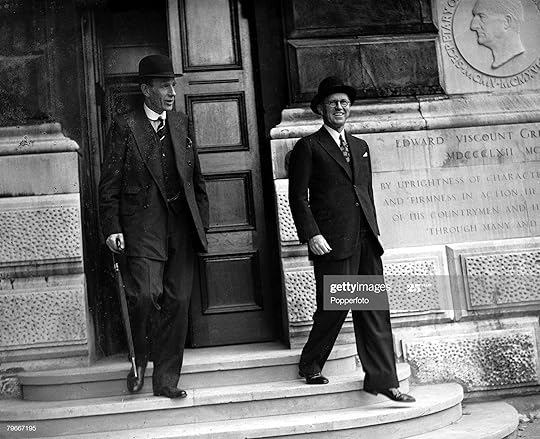
World War II, London, England, 27th August 1939, Edward Wood, Lord Halifax (1881-1959) and Mr Joseph Kennedy, the American Ambassador to Britain, smiling as they leave 10 Downing Street together after a meeting. (Photo by Popperfoto via Getty Images/Getty Images)
"AMERICA LOOMED LARGE IN CHURCHILL’S thinking about the war and its ultimate outcome. Hitler seemed poised to overwhelm Europe. Germany’s air force, the Luftwaffe, was believed to be far larger and more powerful than Britain’s Royal Air Force, the RAF, and its submarines and surface raiders were by now severely impeding the flow of food, arms, and raw materials that were so vital to the island nation.
The prior war had shown how potent the United States could be as a military force, when roused to action; now it alone seemed to have the wherewithal to even the sides.
Just how important America was in Churchill’s strategic thinking became evident to his son, Randolph, one morning soon after Churchill’s appointment, when Randolph walked into his father’s bedroom at Admiralty House and found him standing before a washbasin and mirror, shaving. Randolph was home on leave from the 4th Queen’s Own Hussars, Churchill’s old regiment, in which Randolph now served as an officer.
“Sit down, dear boy, and read the papers while I finish shaving,” Churchill told him. After a few moments, Churchill made a half turn toward his son. “I think I see my way through,” he said. He turned back to the mirror.
Randolph understood that his father was talking about the war. The remark startled him, he recalled, for he himself saw little chance that Britain could win. “Do you mean that we can avoid defeat?” Randolph asked. “Or beat the bastards?”
At this, Churchill threw his razor into the basin and whirled to face his son.
“Of course I mean we can beat them,” he snapped. “Well, I’m all for it,” Randolph said, “but I don’t see how you can do it.”
Churchill dried his face. “I shall drag the United States in.”
Source: Larson, Erik. The Splendid and the Vile (pp. 24-25). Crown. Kindle Edition.
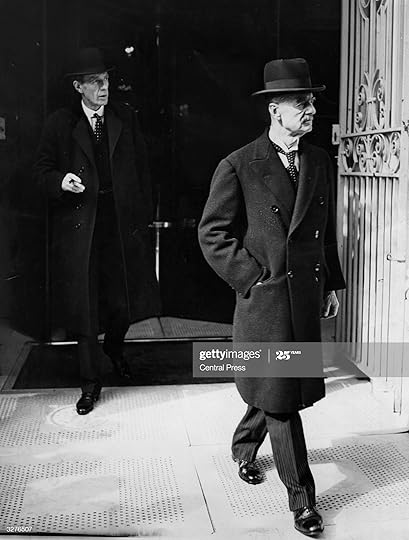
Lord Halifax and Neville Chamberlain - 1st December 1939: Prime Minister Neville Chamberlain walks out of a building. (Photo by Central Press/Getty Images)
Discussion Questions:
1. Churchill appears to believe that all is lost if the United States does not come into the war. And it appears that he is hell bent on making that happen for the survival of Britain. Did you have the impression from this book or other accounts that Churchill felt he could only hold the Germans at bay for a definitive length of time but not indefinitely? Was Churchill's plan the only strategy he had at the time for winning the war. Your thoughts?
2. Was Churchill's pessimism about Britain's chances of winning the war justified? Or was he simply being overly pessimistic - having little faith in the RAF's abilities? It seemed that Churchill and Joseph Kennedy (even though they detested each other) were on the same wave length as to how long England would have lasted.
Was the wife of Churchill’s foreign secretary, Lord Halifax, who detested Joseph Kennedy for his pessimism about Britain’s chances for survival and his prediction that the RAF would quickly be crushed; justifiably upset that Kennedy had so little faith in the RAF?
Many of these pilots risked their lives for Great Britain and should be appreciated for their sacrifices which it is also certain the Churchill did sing their praises often. But did he believe secretly that they alone could turn the tide? That is another question to ponder.
3. Why was there such antipathy for Joseph Kennedy and vice versa?
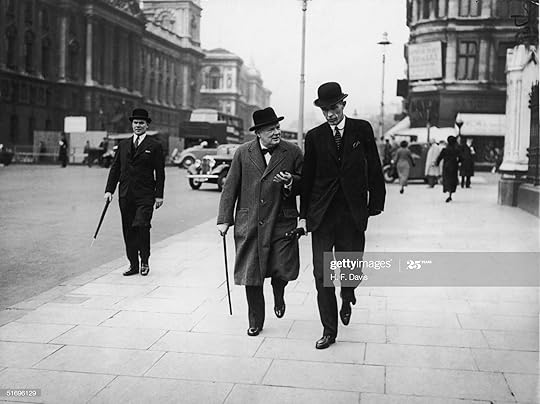
Churchill And Halifax - Winston Churchill (1874 - 1965 left) walking down Whitehall, London, in conversation with British Foreign Secretary Lord Halifax (1881 - 1959), 29th March 1938. (Photo by H. F. Davis/Topical Press Agency/Hulton Archive/Getty Images)

UNITED STATES - JANUARY 01: Lord Halifax, Britain's Ambassador to the US, feeding pet dog Frankie at breakfast with Lady Halifax (Photo by Alfred Eisenstaedt/The LIFE Picture Collection via Getty Images)
Source: Larson, Erik. The Splendid and the Vile (p. 26). Crown. Kindle Edition.

World War II, London, England, 27th August 1939, Edward Wood, Lord Halifax (1881-1959) and Mr Joseph Kennedy, the American Ambassador to Britain, smiling as they leave 10 Downing Street together after a meeting. (Photo by Popperfoto via Getty Images/Getty Images)
"AMERICA LOOMED LARGE IN CHURCHILL’S thinking about the war and its ultimate outcome. Hitler seemed poised to overwhelm Europe. Germany’s air force, the Luftwaffe, was believed to be far larger and more powerful than Britain’s Royal Air Force, the RAF, and its submarines and surface raiders were by now severely impeding the flow of food, arms, and raw materials that were so vital to the island nation.
The prior war had shown how potent the United States could be as a military force, when roused to action; now it alone seemed to have the wherewithal to even the sides.
Just how important America was in Churchill’s strategic thinking became evident to his son, Randolph, one morning soon after Churchill’s appointment, when Randolph walked into his father’s bedroom at Admiralty House and found him standing before a washbasin and mirror, shaving. Randolph was home on leave from the 4th Queen’s Own Hussars, Churchill’s old regiment, in which Randolph now served as an officer.
“Sit down, dear boy, and read the papers while I finish shaving,” Churchill told him. After a few moments, Churchill made a half turn toward his son. “I think I see my way through,” he said. He turned back to the mirror.
Randolph understood that his father was talking about the war. The remark startled him, he recalled, for he himself saw little chance that Britain could win. “Do you mean that we can avoid defeat?” Randolph asked. “Or beat the bastards?”
At this, Churchill threw his razor into the basin and whirled to face his son.
“Of course I mean we can beat them,” he snapped. “Well, I’m all for it,” Randolph said, “but I don’t see how you can do it.”
Churchill dried his face. “I shall drag the United States in.”
Source: Larson, Erik. The Splendid and the Vile (pp. 24-25). Crown. Kindle Edition.

Lord Halifax and Neville Chamberlain - 1st December 1939: Prime Minister Neville Chamberlain walks out of a building. (Photo by Central Press/Getty Images)
Discussion Questions:
1. Churchill appears to believe that all is lost if the United States does not come into the war. And it appears that he is hell bent on making that happen for the survival of Britain. Did you have the impression from this book or other accounts that Churchill felt he could only hold the Germans at bay for a definitive length of time but not indefinitely? Was Churchill's plan the only strategy he had at the time for winning the war. Your thoughts?
2. Was Churchill's pessimism about Britain's chances of winning the war justified? Or was he simply being overly pessimistic - having little faith in the RAF's abilities? It seemed that Churchill and Joseph Kennedy (even though they detested each other) were on the same wave length as to how long England would have lasted.
Was the wife of Churchill’s foreign secretary, Lord Halifax, who detested Joseph Kennedy for his pessimism about Britain’s chances for survival and his prediction that the RAF would quickly be crushed; justifiably upset that Kennedy had so little faith in the RAF?
Many of these pilots risked their lives for Great Britain and should be appreciated for their sacrifices which it is also certain the Churchill did sing their praises often. But did he believe secretly that they alone could turn the tide? That is another question to ponder.
3. Why was there such antipathy for Joseph Kennedy and vice versa?

Churchill And Halifax - Winston Churchill (1874 - 1965 left) walking down Whitehall, London, in conversation with British Foreign Secretary Lord Halifax (1881 - 1959), 29th March 1938. (Photo by H. F. Davis/Topical Press Agency/Hulton Archive/Getty Images)

UNITED STATES - JANUARY 01: Lord Halifax, Britain's Ambassador to the US, feeding pet dog Frankie at breakfast with Lady Halifax (Photo by Alfred Eisenstaedt/The LIFE Picture Collection via Getty Images)
Source: Larson, Erik. The Splendid and the Vile (p. 26). Crown. Kindle Edition.
message 80:
by
Bentley, Group Founder, Leader, Chief
(last edited Jun 01, 2020 10:34PM)
(new)
-
rated it 4 stars
Lord Halifax
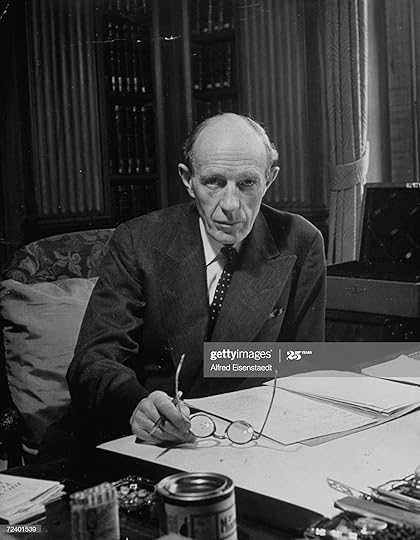
Portrait of Lord Halifax Britain's Ambassador to the US
UNITED STATES - JANUARY 01: Portrait of Lord Halifax, Britain's Ambassador to the US, at his desk. (Photo by Alfred Eisenstaedt/The LIFE Picture Collection via Getty Images)
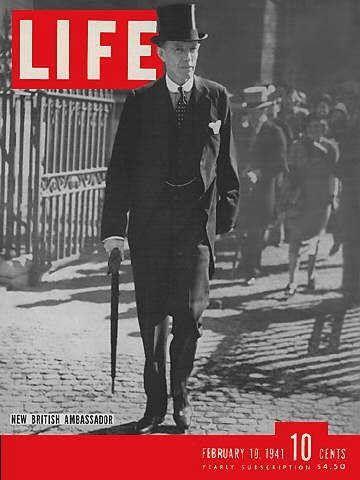
About Lord Halifax
Note: There are many versions related to Lord Halifax - I chose to use the biography posted by the Gov.UK site:
Edward Frederick Lindley Wood, Viscount Halifax
Foreign Secretary February 1938 to December 1940
Lord Halifax took over at the Foreign Office following the resignation of Anthony Eden in February 1938. Eden’s relations with Prime Minister Neville Chamberlain had reached breaking point over the latter’s interference in foreign policy and differences over how best to deal with Germany and Italy.
The Prime Minister wrote privately that Halifax was a more congenial colleague: “I thank God for a steady unruffled Foreign Secretary who never causes me any worry”. He hoped that Halifax would not become infected with the pessimism and suspicion of Hitler and Mussolini which, in Chamberlain’s opinion, some senior Foreign Office officials displayed.
Halifax was nicknamed ‘the Holy Fox’, reflecting his passion for hunting and his Christian moral outlook. He was a man of great stature, who possessed a rational outlook, calm resolution and a conciliatory manner. His air of aristocratic reserve was accompanied by a shrewd political judgement.
Negotiations with Hitler and Mussolini
Halifax agreed with Chamberlain that it was not worth starting a war to defend the crumbling post–war Versailles settlement. Both men initially believed that they could find a satisfactory solution to the demands of Hitler and Mussolini through negotiation and concession. But their traditional ‘gentlemanly’ approach to diplomacy was at odds with the new assertive Fascist leadership and the bullying brinksmanship they practiced.
Halifax realized earlier than Chamberlain, but later than others, that Britain would have to stand firm against Nazi demands for territorial aggrandizement. But it came too late to avoid him being cast in 1940 as one of the ‘Guilty Men’ (in the publication of the same name), held responsible for the war by appeasing fascism.
Halifax was no stranger to foreign affairs having deputized for Eden and acted as spokesman in the Lords since 1935. During the crisis resulting from the Hoare-Laval Pact (which gave Italy territorial concessions at the expense of Abyssinia) Halifax had declared the government’s moral standing was at stake and called for the Foreign Secretary to resign. In November 1937 he had accepted an invitation, as Master of the Middleton Hunt, from Reichsmarschall Hermann Goering to visit a hunting exhibition in Berlin and to shoot foxes with him in Pomerania. Chamberlain pushed for the visit to be used to make contact with the German leadership and sound-out their intentions.
Halifax visited Hitler at his mountain retreat at Berchtesgaden where he nearly mistook the German Chancellor for a footman. He recalled in his memoirs: “As I looked out of the car window, on eye level, I saw in the middle of this swept path a pair of black trousered legs, finishing up in silk socks and pumps. I assumed this was a footman who had come down to help me out of the car and up the steps, and was proceeding in leisurely fashion to get myself out of the car when I heard Von Neurath [the German foreign minister] or somebody throwing a hoarse whisper at my ear of ‘Der Führer, der Führer’; and it then dawned upon me that the legs were not the legs of a footman, but of Hitler” (Halifax, Fulness of Days, London, 1957).
In a 3 hour conversation, Halifax did little to curb Hitler’s ambitions towards Austria and Czechoslovakia with his vague talk of ‘possible alterations in the European order which might be destined to come about with the passage of time’.
The Munich crisis
At first Chamberlain continued to dominate foreign affairs and use personal diplomacy to circumvent the normal diplomatic channels. Even with a Foreign Secretary more to his liking, Chamberlain did not take Halifax with him to the Munich conference in September 1938 at which Czechoslovakia was carved up, and after which Chamberlain infamously declared he had secured ‘peace for our time’. And at a subsequent mission to Italy to woo Mussolini in January 1939, Halifax played only a secondary role.
However during the Munich crisis, conscious as he was of the political mood and public opinion, Halifax’s attitude towards Germany hardened. He was consequently instrumental in modifying Chamberlain’s policies. In September 1938 he led the Cabinet in insisting on making fewer concessions to Germany over the Sudetenland. Following Hitler’s complete annexation of Czechoslovakia, in March 1939, he pushed for Britain to offer a guarantee of security to Poland. Later that summer Halifax also made Chamberlain reassure France very publicly (if rather belatedly) of British military support should it too be invaded by Germany.
The final years in office
Chamberlain resigned as Prime Minister in May 1940 following the debacle of the Norwegian campaign. Halifax was seen as a leading candidate to replace him but he realized that Churchill would make a superior war leader and, pleading ill-health, withdrew from the race.
Halifax remained as Foreign Secretary and has been identified with various peacemaking initiatives in the summer of 1940. Churchill then decided he wanted Eden back as Foreign Secretary and in January 1941 Halifax was persuaded to take up the ambassadorship to Washington. There, after an initially hesitant start, he formed a strong working relationship with President Roosevelt and remained until May 1946.
Source: Gov.UK, Youtube
More:
LORD HALIFAX BROADCASTS - SOUND
Link: https://youtu.be/6U8M4U3hbUk
Lord Halifax's Speech
In this historic camera interview, Lord Halifax with the words of the Premier, states the fundamental truth which binds the country.
Link: https://youtu.be/uDuex9wIA8I
Lord Halifax Leaves For USA, Speech To Americans (1940)
Link: https://youtu.be/nDRbK4uJvnY
Historian J. Rufus Fears on Winston Churchill
Historian J. Rufus Fears chronicled the leadership style of Winston Churchill, who inspired a nation as prime minister of Britain during World War II. He compared him to other world leaders of today and the difference between politicians and statesmen (moral fiber, bedrock of principles - fundamental values upon which you live your live, moral compass, ability to build a consensus). “Winston Churchill: Leadership in a Time of Crisis” was a luncheon address at the Tenth Circuit Bench and Bar Conference, held at The Broadmoor in Colorado Spring
Link: https://www.c-span.org/video/?295250-...
Halifax : the life of Lord Halifax
by Birkenhead, Frederick Winston Furneaux Smith, Earl of, 1907-1975
Link: https://archive.org/details/halifax00...
 by
by
 J. Rufus Fears
J. Rufus Fears
 by
by
 Andrew Roberts
Andrew Roberts

Portrait of Lord Halifax Britain's Ambassador to the US
UNITED STATES - JANUARY 01: Portrait of Lord Halifax, Britain's Ambassador to the US, at his desk. (Photo by Alfred Eisenstaedt/The LIFE Picture Collection via Getty Images)

About Lord Halifax
Note: There are many versions related to Lord Halifax - I chose to use the biography posted by the Gov.UK site:
Edward Frederick Lindley Wood, Viscount Halifax
Foreign Secretary February 1938 to December 1940
Lord Halifax took over at the Foreign Office following the resignation of Anthony Eden in February 1938. Eden’s relations with Prime Minister Neville Chamberlain had reached breaking point over the latter’s interference in foreign policy and differences over how best to deal with Germany and Italy.
The Prime Minister wrote privately that Halifax was a more congenial colleague: “I thank God for a steady unruffled Foreign Secretary who never causes me any worry”. He hoped that Halifax would not become infected with the pessimism and suspicion of Hitler and Mussolini which, in Chamberlain’s opinion, some senior Foreign Office officials displayed.
Halifax was nicknamed ‘the Holy Fox’, reflecting his passion for hunting and his Christian moral outlook. He was a man of great stature, who possessed a rational outlook, calm resolution and a conciliatory manner. His air of aristocratic reserve was accompanied by a shrewd political judgement.
Negotiations with Hitler and Mussolini
Halifax agreed with Chamberlain that it was not worth starting a war to defend the crumbling post–war Versailles settlement. Both men initially believed that they could find a satisfactory solution to the demands of Hitler and Mussolini through negotiation and concession. But their traditional ‘gentlemanly’ approach to diplomacy was at odds with the new assertive Fascist leadership and the bullying brinksmanship they practiced.
Halifax realized earlier than Chamberlain, but later than others, that Britain would have to stand firm against Nazi demands for territorial aggrandizement. But it came too late to avoid him being cast in 1940 as one of the ‘Guilty Men’ (in the publication of the same name), held responsible for the war by appeasing fascism.
Halifax was no stranger to foreign affairs having deputized for Eden and acted as spokesman in the Lords since 1935. During the crisis resulting from the Hoare-Laval Pact (which gave Italy territorial concessions at the expense of Abyssinia) Halifax had declared the government’s moral standing was at stake and called for the Foreign Secretary to resign. In November 1937 he had accepted an invitation, as Master of the Middleton Hunt, from Reichsmarschall Hermann Goering to visit a hunting exhibition in Berlin and to shoot foxes with him in Pomerania. Chamberlain pushed for the visit to be used to make contact with the German leadership and sound-out their intentions.
Halifax visited Hitler at his mountain retreat at Berchtesgaden where he nearly mistook the German Chancellor for a footman. He recalled in his memoirs: “As I looked out of the car window, on eye level, I saw in the middle of this swept path a pair of black trousered legs, finishing up in silk socks and pumps. I assumed this was a footman who had come down to help me out of the car and up the steps, and was proceeding in leisurely fashion to get myself out of the car when I heard Von Neurath [the German foreign minister] or somebody throwing a hoarse whisper at my ear of ‘Der Führer, der Führer’; and it then dawned upon me that the legs were not the legs of a footman, but of Hitler” (Halifax, Fulness of Days, London, 1957).
In a 3 hour conversation, Halifax did little to curb Hitler’s ambitions towards Austria and Czechoslovakia with his vague talk of ‘possible alterations in the European order which might be destined to come about with the passage of time’.
The Munich crisis
At first Chamberlain continued to dominate foreign affairs and use personal diplomacy to circumvent the normal diplomatic channels. Even with a Foreign Secretary more to his liking, Chamberlain did not take Halifax with him to the Munich conference in September 1938 at which Czechoslovakia was carved up, and after which Chamberlain infamously declared he had secured ‘peace for our time’. And at a subsequent mission to Italy to woo Mussolini in January 1939, Halifax played only a secondary role.
However during the Munich crisis, conscious as he was of the political mood and public opinion, Halifax’s attitude towards Germany hardened. He was consequently instrumental in modifying Chamberlain’s policies. In September 1938 he led the Cabinet in insisting on making fewer concessions to Germany over the Sudetenland. Following Hitler’s complete annexation of Czechoslovakia, in March 1939, he pushed for Britain to offer a guarantee of security to Poland. Later that summer Halifax also made Chamberlain reassure France very publicly (if rather belatedly) of British military support should it too be invaded by Germany.
The final years in office
Chamberlain resigned as Prime Minister in May 1940 following the debacle of the Norwegian campaign. Halifax was seen as a leading candidate to replace him but he realized that Churchill would make a superior war leader and, pleading ill-health, withdrew from the race.
Halifax remained as Foreign Secretary and has been identified with various peacemaking initiatives in the summer of 1940. Churchill then decided he wanted Eden back as Foreign Secretary and in January 1941 Halifax was persuaded to take up the ambassadorship to Washington. There, after an initially hesitant start, he formed a strong working relationship with President Roosevelt and remained until May 1946.
Source: Gov.UK, Youtube
More:
LORD HALIFAX BROADCASTS - SOUND
Link: https://youtu.be/6U8M4U3hbUk
Lord Halifax's Speech
In this historic camera interview, Lord Halifax with the words of the Premier, states the fundamental truth which binds the country.
Link: https://youtu.be/uDuex9wIA8I
Lord Halifax Leaves For USA, Speech To Americans (1940)
Link: https://youtu.be/nDRbK4uJvnY
Historian J. Rufus Fears on Winston Churchill
Historian J. Rufus Fears chronicled the leadership style of Winston Churchill, who inspired a nation as prime minister of Britain during World War II. He compared him to other world leaders of today and the difference between politicians and statesmen (moral fiber, bedrock of principles - fundamental values upon which you live your live, moral compass, ability to build a consensus). “Winston Churchill: Leadership in a Time of Crisis” was a luncheon address at the Tenth Circuit Bench and Bar Conference, held at The Broadmoor in Colorado Spring
Link: https://www.c-span.org/video/?295250-...
Halifax : the life of Lord Halifax
by Birkenhead, Frederick Winston Furneaux Smith, Earl of, 1907-1975
Link: https://archive.org/details/halifax00...
 by
by
 J. Rufus Fears
J. Rufus Fears by
by
 Andrew Roberts
Andrew Roberts
message 81:
by
Bentley, Group Founder, Leader, Chief
(last edited Jun 01, 2020 08:22PM)
(new)
-
rated it 4 stars
Background Information:
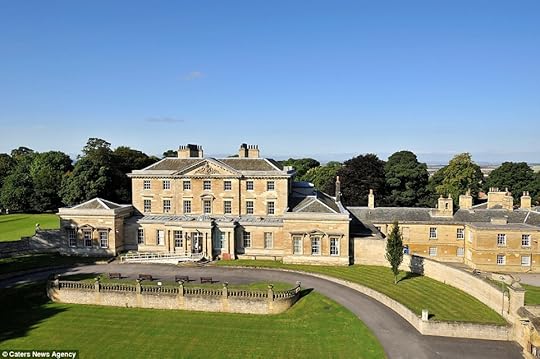
Lord Halifax's 64-bedroom mansion near Doncaster, South Yorkshire, (pictured) where he hatched his leadership bid against Sir Winston Churchill
The 1935 general election had resulted in a Conservative victory with a substantial majority and Stanley Baldwin became Prime Minister. In May 1937, Baldwin retired and was succeeded by Neville Chamberlain who continued Baldwin's foreign policy of appeasement in the face of German, Italian and Japanese aggression.
Having signed the Munich Agreement with Hitler in 1938, Chamberlain became alarmed by the dictator's continuing aggression and, in August 1939, signed the Anglo-Polish military alliance which guaranteed British support for Poland if attacked by Germany. Chamberlain issued the declaration of war against Germany on 3 September 1939 and formed a war cabinet which included Winston Churchill (out of office since June 1929) as First Lord of the Admiralty and Viscount Halifax as Foreign Secretary.
Dissatisfaction with Chamberlain's leadership became widespread in the spring of 1940 when Germany successfully invaded Norway. On 7–8 May, the House of Commons debated the Norwegian campaign, which had gone badly for the Allies. The Norway Debate escalated into widespread criticism not only of the campaign but also of the Conservative-led government's conduct of the entire war. At the end of the second day, the opposition Labour Party forced a division which amounted to a motion of no confidence in Chamberlain's leadership.
Chamberlain as Prime Minister was heavily criticized on both sides of the House by members expressing a strong desire for national unity.
The Conservative rebels mostly wanted the formation of a national government.
Churchill made the closing speech in the Norway Debate and mounted a strong defense of Chamberlain, ending his speech with these words:
At no time in the last war were we in greater peril than we are now, and I urge the House strongly to deal with these matters not in a precipitate vote, ill debated and on a widely discursive field, but in grave time and due time in accordance with the dignity of Parliament.
The government's notional majority was 213, but 41 members who normally supported the government voted with the Opposition while an estimated 60 other Conservatives deliberately abstained.
The government still won the vote by 281 to 200, but their majority was reduced to 81. This would normally be sustainable but, at a time of national crisis with Great Britain losing the war, it was a shattering blow for Chamberlain.
Next day, Thursday, 9 May, Chamberlain attempted to form a National Coalition Government. In talks at 10, Downing Street with Churchill and Halifax, Chamberlain indicated his willingness to resign if that was necessary for Labour to enter such a government.
Labour's leader Clement Attlee and his deputy Arthur Greenwood then joined the meeting and, when asked if they would serve in a coalition, they said they must first consult their party's National Executive Committee, who were then in Bournemouth preparing for the annual party conference that was to start the following Monday.
Even so, they indicated that it was unlikely they could serve in a government led by Chamberlain; they probably would be able to serve under another Conservative. They agreed to telephone on Friday afternoon with the result of their consultation.
Earlier on Thursday, Chamberlain had met Halifax alone and had tried to persuade him to be his successor. Halifax would probably have been the Conservative Party's preferred candidate. Halifax replied that, as a peer and not therefore a member of the Commons, he would be seriously disadvantaged as Prime Minister and would have to delegate direction of the war effort to Churchill in the Commons.
He did not change his position when the same question arose at the evening meeting in which Chamberlain and Halifax were joined by Churchill and the party's Chief Whip, David Margesson.
Churchill's own account of these events, written six years later, is not accurate. It describes the events of 9 May as taking place the following day, and the description of Chamberlain attempting to persuade him to agree tacitly to Halifax's appointment as Prime Minister does not tally with Halifax having expressed his reluctance to do so at the morning meeting with Chamberlain.
The Wehrmacht launched its blitzkrieg against western Europe on the morning of Friday, 10 May, by invading Belgium, Luxembourg and the Netherlands. Given this new crisis, Chamberlain at first declared that he would not resign but he decided after all to await the Labour Party's decision, which he did not receive until late afternoon.
Attlee telephoned Downing Street at about 4:45 pm to confirm that Labour would join a coalition government, but not under Chamberlain's leadership.
Accordingly, Chamberlain went to Buckingham Palace where he had an audience with George VI at 6:00 pm. He tendered his resignation and, after the King asked him who should be his successor, recommended Churchill. The King sent for Churchill who agreed to form a coalition government and the public announcement was made by Chamberlain on BBC Radio at 9:00 pm.
On Saturday, 11 May, the Labour Party agreed to join the national government under Churchill's leadership and he was able to form his war cabinet which, at the outset, was restricted to five members including himself as Prime Minister and Minister of Defense.
Attlee relinquished his official role as Leader of the Opposition to become Lord Privy Seal (until 19 February 1942 when he was appointed Deputy Prime Minister) and Greenwood was appointed a Minister without Portfolio.
The main problem for Churchill as he became Prime Minister was that he was not the leader of the Conservative Party and so he was obliged to include Chamberlain in the war cabinet, as Lord President of the Council, and to retain Halifax as Foreign Secretary.
The war cabinet was augmented by the three service ministers who attended most of its meetings and these were Churchill appointees on whose support he could generally rely. Anthony Eden became Secretary of State for War, Labour's A. V. Alexander succeeded Churchill as First Lord of the Admiralty and the leader of the Liberal Party, Sir Archibald Sinclair, became Secretary of State for Air.
Source: Wikipedia

Lord Halifax's 64-bedroom mansion near Doncaster, South Yorkshire, (pictured) where he hatched his leadership bid against Sir Winston Churchill
The 1935 general election had resulted in a Conservative victory with a substantial majority and Stanley Baldwin became Prime Minister. In May 1937, Baldwin retired and was succeeded by Neville Chamberlain who continued Baldwin's foreign policy of appeasement in the face of German, Italian and Japanese aggression.
Having signed the Munich Agreement with Hitler in 1938, Chamberlain became alarmed by the dictator's continuing aggression and, in August 1939, signed the Anglo-Polish military alliance which guaranteed British support for Poland if attacked by Germany. Chamberlain issued the declaration of war against Germany on 3 September 1939 and formed a war cabinet which included Winston Churchill (out of office since June 1929) as First Lord of the Admiralty and Viscount Halifax as Foreign Secretary.
Dissatisfaction with Chamberlain's leadership became widespread in the spring of 1940 when Germany successfully invaded Norway. On 7–8 May, the House of Commons debated the Norwegian campaign, which had gone badly for the Allies. The Norway Debate escalated into widespread criticism not only of the campaign but also of the Conservative-led government's conduct of the entire war. At the end of the second day, the opposition Labour Party forced a division which amounted to a motion of no confidence in Chamberlain's leadership.
Chamberlain as Prime Minister was heavily criticized on both sides of the House by members expressing a strong desire for national unity.
The Conservative rebels mostly wanted the formation of a national government.
Churchill made the closing speech in the Norway Debate and mounted a strong defense of Chamberlain, ending his speech with these words:
At no time in the last war were we in greater peril than we are now, and I urge the House strongly to deal with these matters not in a precipitate vote, ill debated and on a widely discursive field, but in grave time and due time in accordance with the dignity of Parliament.
The government's notional majority was 213, but 41 members who normally supported the government voted with the Opposition while an estimated 60 other Conservatives deliberately abstained.
The government still won the vote by 281 to 200, but their majority was reduced to 81. This would normally be sustainable but, at a time of national crisis with Great Britain losing the war, it was a shattering blow for Chamberlain.
Next day, Thursday, 9 May, Chamberlain attempted to form a National Coalition Government. In talks at 10, Downing Street with Churchill and Halifax, Chamberlain indicated his willingness to resign if that was necessary for Labour to enter such a government.
Labour's leader Clement Attlee and his deputy Arthur Greenwood then joined the meeting and, when asked if they would serve in a coalition, they said they must first consult their party's National Executive Committee, who were then in Bournemouth preparing for the annual party conference that was to start the following Monday.
Even so, they indicated that it was unlikely they could serve in a government led by Chamberlain; they probably would be able to serve under another Conservative. They agreed to telephone on Friday afternoon with the result of their consultation.
Earlier on Thursday, Chamberlain had met Halifax alone and had tried to persuade him to be his successor. Halifax would probably have been the Conservative Party's preferred candidate. Halifax replied that, as a peer and not therefore a member of the Commons, he would be seriously disadvantaged as Prime Minister and would have to delegate direction of the war effort to Churchill in the Commons.
He did not change his position when the same question arose at the evening meeting in which Chamberlain and Halifax were joined by Churchill and the party's Chief Whip, David Margesson.
Churchill's own account of these events, written six years later, is not accurate. It describes the events of 9 May as taking place the following day, and the description of Chamberlain attempting to persuade him to agree tacitly to Halifax's appointment as Prime Minister does not tally with Halifax having expressed his reluctance to do so at the morning meeting with Chamberlain.
The Wehrmacht launched its blitzkrieg against western Europe on the morning of Friday, 10 May, by invading Belgium, Luxembourg and the Netherlands. Given this new crisis, Chamberlain at first declared that he would not resign but he decided after all to await the Labour Party's decision, which he did not receive until late afternoon.
Attlee telephoned Downing Street at about 4:45 pm to confirm that Labour would join a coalition government, but not under Chamberlain's leadership.
Accordingly, Chamberlain went to Buckingham Palace where he had an audience with George VI at 6:00 pm. He tendered his resignation and, after the King asked him who should be his successor, recommended Churchill. The King sent for Churchill who agreed to form a coalition government and the public announcement was made by Chamberlain on BBC Radio at 9:00 pm.
On Saturday, 11 May, the Labour Party agreed to join the national government under Churchill's leadership and he was able to form his war cabinet which, at the outset, was restricted to five members including himself as Prime Minister and Minister of Defense.
Attlee relinquished his official role as Leader of the Opposition to become Lord Privy Seal (until 19 February 1942 when he was appointed Deputy Prime Minister) and Greenwood was appointed a Minister without Portfolio.
The main problem for Churchill as he became Prime Minister was that he was not the leader of the Conservative Party and so he was obliged to include Chamberlain in the war cabinet, as Lord President of the Council, and to retain Halifax as Foreign Secretary.
The war cabinet was augmented by the three service ministers who attended most of its meetings and these were Churchill appointees on whose support he could generally rely. Anthony Eden became Secretary of State for War, Labour's A. V. Alexander succeeded Churchill as First Lord of the Admiralty and the leader of the Liberal Party, Sir Archibald Sinclair, became Secretary of State for Air.
Source: Wikipedia
message 82:
by
Bentley, Group Founder, Leader, Chief
(last edited Jun 02, 2020 12:10AM)
(new)
-
rated it 4 stars
Joseph Patrick Kennedy, Sr.
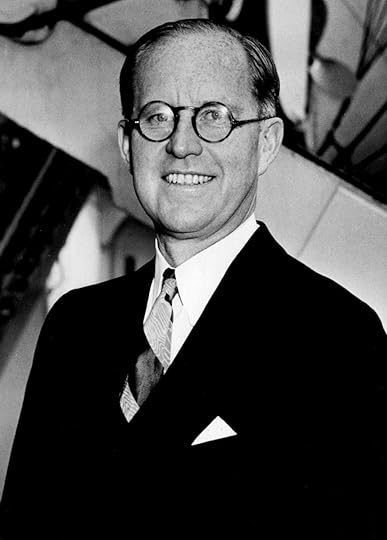
Photo of Joseph P. Kennedy, Sr. He was the United States Ambassador to Great Britain at the time this photo was taken.
Joseph Patrick Kennedy (September 6, 1888 – November 18, 1969) was an American businessman, investor and politician known for his high-profile positions in United States government and for the political and other achievements of his children.
Kennedy was born to a political family in East Boston, Massachusetts. He made a large fortune as a stock market and commodity investor and later rolled over his profits by investing in real estate and a wide range of business industries across the United States. During World War I, he was an assistant general manager of a Boston area Bethlehem Steel shipyard; through this position, he became acquainted with Franklin D. Roosevelt, who was the Assistant Secretary of the Navy. In the 1920s, Kennedy made huge profits by reorganizing and refinancing several Hollywood studios; several acquisitions were ultimately merged into Radio-Keith-Orpheum (RKO) studios. Kennedy increased his fortune with distribution rights for Scotch whisky. He owned the largest privately owned building in the country, Chicago's Merchandise Mart.
Kennedy was a leading member of the Democratic Party and of the Irish Catholic community. President Franklin D. Roosevelt appointed Kennedy to be the first chairman of the U.S. Securities and Exchange Commission (SEC), which he led from 1934 to 1935. Kennedy later directed the Maritime Commission. Kennedy served as the United States Ambassador to the United Kingdom from 1938 until late 1940. With the outbreak of World War II in September 1939, Kennedy was pessimistic about Britain's ability to survive Nazi Germany's attacks. During the Battle of Britain in November 1940, Kennedy publicly suggested that "Democracy is finished in England. It may be here [in the United States]". Following this controversy, Kennedy resigned his position.
Kennedy was married to Rose Kennedy. During his later life he was heavily involved in the political careers of his sons. Three of Kennedy's sons attained distinguished political positions: John F. Kennedy (1917–1963) served as a U.S. Senator from Massachusetts and as President of the United States, Robert F. Kennedy (1925–1968) served as Attorney General and as a U.S. Senator from New York, and Ted Kennedy (1932–2009) also served as a U.S. Senator from Massachusetts.
Remainder of article:
https://en.wikipedia.org/wiki/Joseph_....
Source: Wikipedia, Biography, Youtube
More:
https://www.nytimes.com/2012/11/18/bo...
https://www.findagrave.com/memorial/572
http://docs.fdrlibrary.marist.edu/psf...
https://www.vanityfair.com/news/2009/...
https://www.biography.com/video/josep...
Biography:
Video: https://www.biography.com/video/josep...
Freedom Of Edinburgh For Joseph P Kennedy (1939)
Video: https://youtu.be/iC0NlhSpPVU
Joseph Kennedy, New US Ambassador
Video: https://youtu.be/60BAp-2qAho
Joe Kennedy On New Marine Service
Video: https://youtu.be/7_aJlloJ8hI
New Us Ambassador Interviewed In London (1938)
Video: https://youtu.be/TLGMgpBjhCk
Former Ambassador to the UK Joseph Kennedy testifies before House Foreign Affairs...HD Stock Footage (not the best quality but archival)
Former US Ambassador to the Court of St James (United Kingdom) Joseph Kennedy testifies on Britain's wartime situation before House Foreign Affairs Committee conducting hearings related to House Bill 1776 (Lend Lease) in Washington DC during World War II. Kennedy replies upon being questioned about wartime situation in Britain. He speaks about destruction of ships and says that the situation in Britain is critical since fall of France. Crowd seated. Location: United States. Date: January 1941.
Video: https://youtu.be/_NhYtocv6oA
US Ambassador to UK, Joseph Kennedy, arrives aboard Pan American Clipper from Eng...HD Stock Footage
US Ambassador to UK, Joseph Kennedy, arrives aboard Pan American Clipper from England during World War II - US Ambassador to UK Joseph Kennedy arrives in New York City, aboard a Pan American Clipper from England, during World War II. Pan American Clipper in flight. Clipper descends and lands in Flushing Bay, and taxis on water (using outboard engines, only) towards dock at Laguardia Seaplane base in New York City. Joseph Kennedy and his family gather together on dock after disembarking from the clipper. His wife, Rose Kennedy is seen. He refuses to have a word with reporters until he sees US President Franklin Roosevelt. Kennedy with officials and a policeman walking past the terminal building. Location: New York City. Date: 1940.
Video: https://youtu.be/-kTtUb-_woM
Joseph Kennedy speaks in favor of keeping United States out of World War II during his speech in Washington D.C.
Former US Ambassador to UK, Joseph Kennedy records a speech in Washington D.C., United States during World War II. He says that Congress should not abdicate completely its authority or power. He further says United States should not go to war unless attacked. He favors making the United States militarily strong, especially in airpower. He emphasizes that the US should avoid getting involved in war. Location: Washington DC. Date: 1941.
Video: https://youtu.be/CSptCL-Q3i4
Envoy Sails Aka JP Kennedy Leaves America For England (1938)
Video: https://youtu.be/hYEg8S5yMRw
Mr Joseph P Kennedy Says Au Revoir (1940)
Video: https://youtu.be/Ohto-M7Sf4c
 by
by
 David Nasaw
David Nasaw
 by Ronald Kessler (no photo)
by Ronald Kessler (no photo)

Photo of Joseph P. Kennedy, Sr. He was the United States Ambassador to Great Britain at the time this photo was taken.
Joseph Patrick Kennedy (September 6, 1888 – November 18, 1969) was an American businessman, investor and politician known for his high-profile positions in United States government and for the political and other achievements of his children.
Kennedy was born to a political family in East Boston, Massachusetts. He made a large fortune as a stock market and commodity investor and later rolled over his profits by investing in real estate and a wide range of business industries across the United States. During World War I, he was an assistant general manager of a Boston area Bethlehem Steel shipyard; through this position, he became acquainted with Franklin D. Roosevelt, who was the Assistant Secretary of the Navy. In the 1920s, Kennedy made huge profits by reorganizing and refinancing several Hollywood studios; several acquisitions were ultimately merged into Radio-Keith-Orpheum (RKO) studios. Kennedy increased his fortune with distribution rights for Scotch whisky. He owned the largest privately owned building in the country, Chicago's Merchandise Mart.
Kennedy was a leading member of the Democratic Party and of the Irish Catholic community. President Franklin D. Roosevelt appointed Kennedy to be the first chairman of the U.S. Securities and Exchange Commission (SEC), which he led from 1934 to 1935. Kennedy later directed the Maritime Commission. Kennedy served as the United States Ambassador to the United Kingdom from 1938 until late 1940. With the outbreak of World War II in September 1939, Kennedy was pessimistic about Britain's ability to survive Nazi Germany's attacks. During the Battle of Britain in November 1940, Kennedy publicly suggested that "Democracy is finished in England. It may be here [in the United States]". Following this controversy, Kennedy resigned his position.
Kennedy was married to Rose Kennedy. During his later life he was heavily involved in the political careers of his sons. Three of Kennedy's sons attained distinguished political positions: John F. Kennedy (1917–1963) served as a U.S. Senator from Massachusetts and as President of the United States, Robert F. Kennedy (1925–1968) served as Attorney General and as a U.S. Senator from New York, and Ted Kennedy (1932–2009) also served as a U.S. Senator from Massachusetts.
Remainder of article:
https://en.wikipedia.org/wiki/Joseph_....
Source: Wikipedia, Biography, Youtube
More:
https://www.nytimes.com/2012/11/18/bo...
https://www.findagrave.com/memorial/572
http://docs.fdrlibrary.marist.edu/psf...
https://www.vanityfair.com/news/2009/...
https://www.biography.com/video/josep...
Biography:
Video: https://www.biography.com/video/josep...
Freedom Of Edinburgh For Joseph P Kennedy (1939)
Video: https://youtu.be/iC0NlhSpPVU
Joseph Kennedy, New US Ambassador
Video: https://youtu.be/60BAp-2qAho
Joe Kennedy On New Marine Service
Video: https://youtu.be/7_aJlloJ8hI
New Us Ambassador Interviewed In London (1938)
Video: https://youtu.be/TLGMgpBjhCk
Former Ambassador to the UK Joseph Kennedy testifies before House Foreign Affairs...HD Stock Footage (not the best quality but archival)
Former US Ambassador to the Court of St James (United Kingdom) Joseph Kennedy testifies on Britain's wartime situation before House Foreign Affairs Committee conducting hearings related to House Bill 1776 (Lend Lease) in Washington DC during World War II. Kennedy replies upon being questioned about wartime situation in Britain. He speaks about destruction of ships and says that the situation in Britain is critical since fall of France. Crowd seated. Location: United States. Date: January 1941.
Video: https://youtu.be/_NhYtocv6oA
US Ambassador to UK, Joseph Kennedy, arrives aboard Pan American Clipper from Eng...HD Stock Footage
US Ambassador to UK, Joseph Kennedy, arrives aboard Pan American Clipper from England during World War II - US Ambassador to UK Joseph Kennedy arrives in New York City, aboard a Pan American Clipper from England, during World War II. Pan American Clipper in flight. Clipper descends and lands in Flushing Bay, and taxis on water (using outboard engines, only) towards dock at Laguardia Seaplane base in New York City. Joseph Kennedy and his family gather together on dock after disembarking from the clipper. His wife, Rose Kennedy is seen. He refuses to have a word with reporters until he sees US President Franklin Roosevelt. Kennedy with officials and a policeman walking past the terminal building. Location: New York City. Date: 1940.
Video: https://youtu.be/-kTtUb-_woM
Joseph Kennedy speaks in favor of keeping United States out of World War II during his speech in Washington D.C.
Former US Ambassador to UK, Joseph Kennedy records a speech in Washington D.C., United States during World War II. He says that Congress should not abdicate completely its authority or power. He further says United States should not go to war unless attacked. He favors making the United States militarily strong, especially in airpower. He emphasizes that the US should avoid getting involved in war. Location: Washington DC. Date: 1941.
Video: https://youtu.be/CSptCL-Q3i4
Envoy Sails Aka JP Kennedy Leaves America For England (1938)
Video: https://youtu.be/hYEg8S5yMRw
Mr Joseph P Kennedy Says Au Revoir (1940)
Video: https://youtu.be/Ohto-M7Sf4c
 by
by
 David Nasaw
David Nasaw by Ronald Kessler (no photo)
by Ronald Kessler (no photo)
message 83:
by
Bentley, Group Founder, Leader, Chief
(last edited Jun 01, 2020 11:14PM)
(new)
-
rated it 4 stars
Today's Progress:
Week Two's Assignment beginning next Monday - June 1st
It is never too late to join a buddy read.
Week Two - June 1st - June 7th -
✓Chapter 3: London and Washington - page 24 - The moderator has completed adding material, discussion questions, etc. for this chapter - Complete
Chapter 4: Galvanized - page 27 - begins next
Chapter 5: Moondread - page 39 - not begun
Good night!
Please post and discuss any aspect of any pages through the end of Chapter 5 - with no spoilers necessary, If you go ahead - use spoiler html or post on the glossary thread.
Week Two's Assignment beginning next Monday - June 1st
It is never too late to join a buddy read.
Week Two - June 1st - June 7th -
✓Chapter 3: London and Washington - page 24 - The moderator has completed adding material, discussion questions, etc. for this chapter - Complete
Chapter 4: Galvanized - page 27 - begins next
Chapter 5: Moondread - page 39 - not begun
Good night!
Please post and discuss any aspect of any pages through the end of Chapter 5 - with no spoilers necessary, If you go ahead - use spoiler html or post on the glossary thread.
 way cool about the maginot line (near the top of page 2)!! loved the pix, not being a WWII buff, I now learned about what the term 'maginot line' means! and I would agree it did work as intended, since Germany didn't directly attack through it...
way cool about the maginot line (near the top of page 2)!! loved the pix, not being a WWII buff, I now learned about what the term 'maginot line' means! and I would agree it did work as intended, since Germany didn't directly attack through it...
Marc- glad you liked it. I was fortunate enough to see some of these firmaments when traveling in France. As moderator I try to fill in the blanks so that as you read you have some additional background information. I agree. Although they did gain access through the Ardennes Woods link - they exploited it there but you are right their main offensive was through the Lowlands.
message 86:
by
Bentley, Group Founder, Leader, Chief
(last edited Jun 04, 2020 03:58AM)
(new)
-
rated it 4 stars
And so chapter four begins:
CHAPTER 4
Galvanized
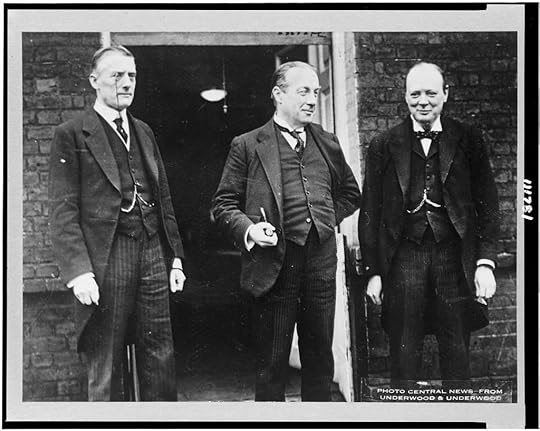
Standing, left to right: Mr. Austen Chamberlain, Premier Stanley Baldwin, and Sir Winston Churchill] / Photo Central News from Underwood & Underwood
IN HIS FIRST TWENTY-FOUR HOURS in office, Churchill revealed himself to be a very different kind of prime minister. Where Chamberlain—the Old Umbrella, the Coroner—was staid and deliberate, the new prime minister, true to his reputation, was flamboyant, electric, and wholly unpredictable.
One of Churchill’s first acts was to appoint himself minister of defense, which prompted an outgoing official to write in his diary, “Heaven help us.” The post was a new one, through which Churchill would oversee the chiefs of staff who controlled the army, navy, and air force. He now had full control of the war, and full responsibility.
Source: Larson, Erik. The Splendid and the Vile (p. 27). Crown. Kindle Edition.
More:
How Winston Churchill Pulled Britain Through The Early Years Of WWII - NPR for Central California (with Eric Larson)
Audio link: https://www.kvpr.org/post/how-winston...
Minister of Defense
Link: https://en.wikipedia.org/wiki/Ministe....
History:
"Prior to the outbreak of the Second World War, concerns about British forces being understrength led in 1936 to the creation of the post of Minister for Coordination of Defense by Prime Minister Stanley Baldwin. The post was abolished by Baldwin's successor Neville Chamberlain in April 1940.
On his appointment as Prime Minister in May 1940, Winston Churchill created for himself the new post of Minister of Defense. The post was created in response to previous criticism that there had been no clear single minister in charge of the prosecution of the war. In 1946, the post became the only cabinet-level post representing the military, with the three service ministers—the Secretary of State for War, the First Lord of the Admiralty, and the Secretary of State for Air—now formally subordinated to the Minister of Defense.
In 1964, the creation of a single, merged Ministry of Defence and the abolition of the separate service ministries in the UK led to the creation of the new post of Secretary of State for Defence, more popularly known as Defense Secretary."
More:
How Stanley Baldwin Spied on Edward VIII (interesting)
Link: https://www.dailymail.co.uk/femail/ar...
Dunkirk Delusion
Link: https://www.newstatesman.com/politics...
Sources: Wikipedia, NPR, Daily Mail
CHAPTER 4
Galvanized

Standing, left to right: Mr. Austen Chamberlain, Premier Stanley Baldwin, and Sir Winston Churchill] / Photo Central News from Underwood & Underwood
IN HIS FIRST TWENTY-FOUR HOURS in office, Churchill revealed himself to be a very different kind of prime minister. Where Chamberlain—the Old Umbrella, the Coroner—was staid and deliberate, the new prime minister, true to his reputation, was flamboyant, electric, and wholly unpredictable.
One of Churchill’s first acts was to appoint himself minister of defense, which prompted an outgoing official to write in his diary, “Heaven help us.” The post was a new one, through which Churchill would oversee the chiefs of staff who controlled the army, navy, and air force. He now had full control of the war, and full responsibility.
Source: Larson, Erik. The Splendid and the Vile (p. 27). Crown. Kindle Edition.
More:
How Winston Churchill Pulled Britain Through The Early Years Of WWII - NPR for Central California (with Eric Larson)
Audio link: https://www.kvpr.org/post/how-winston...
Minister of Defense
Link: https://en.wikipedia.org/wiki/Ministe....
History:
"Prior to the outbreak of the Second World War, concerns about British forces being understrength led in 1936 to the creation of the post of Minister for Coordination of Defense by Prime Minister Stanley Baldwin. The post was abolished by Baldwin's successor Neville Chamberlain in April 1940.
On his appointment as Prime Minister in May 1940, Winston Churchill created for himself the new post of Minister of Defense. The post was created in response to previous criticism that there had been no clear single minister in charge of the prosecution of the war. In 1946, the post became the only cabinet-level post representing the military, with the three service ministers—the Secretary of State for War, the First Lord of the Admiralty, and the Secretary of State for Air—now formally subordinated to the Minister of Defense.
In 1964, the creation of a single, merged Ministry of Defence and the abolition of the separate service ministries in the UK led to the creation of the new post of Secretary of State for Defence, more popularly known as Defense Secretary."
More:
How Stanley Baldwin Spied on Edward VIII (interesting)
Link: https://www.dailymail.co.uk/femail/ar...
Dunkirk Delusion
Link: https://www.newstatesman.com/politics...
Sources: Wikipedia, NPR, Daily Mail
Members, what are your thoughts about the book so far? Did you learn anything new about Churchill or the war?
 I'll jump in whenever I get my hands on the book. I am currently # 12 on the waiting list at LA county Library system. I finally see movement now that the libraries are partially reopening.
I'll jump in whenever I get my hands on the book. I am currently # 12 on the waiting list at LA county Library system. I finally see movement now that the libraries are partially reopening.
message 89:
by
Bentley, Group Founder, Leader, Chief
(last edited Jun 04, 2020 06:36PM)
(new)
-
rated it 4 stars
Michelle - hello. I am excited about you getting your book. Being number 12 on a waiting list in LA can't be too bad - they must have multiple books. I am sure that things will start moving along fast now.
Thank you for letting us know your progress. The book is very easy reading so you should not have any issues with it.
Thank you for letting us know your progress. The book is very easy reading so you should not have any issues with it.
message 90:
by
Bentley, Group Founder, Leader, Chief
(last edited Jun 06, 2020 11:27PM)
(new)
-
rated it 4 stars
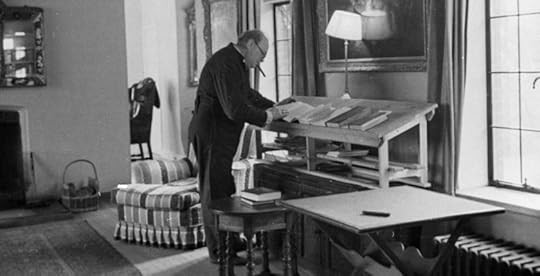
Churchill in his Chartwell study at his original stand-up desk, roughly hewn to his own design by a carpenter, placed on a trunk to give it the preferred height. Later his family presented him with a fine mahogany version built by a joiner, which remains there today. (National Trust)
Discussion Topics and Questions:
1. What did we learn in Chapter Four about Winston Churchill's stamina and energy?
2. Was he patient with his staff and what were his pet peeves - which ones did you find peculiar if any? Which ones did you applaud? Here is one: “It is slothful not to compress your thoughts,” he said.
Source: Larson, Erik. The Splendid and the Vile (p. 28). Crown. Kindle Edition.
3. How was the work environment and the level of staff engagement different from the Chamberlain years to the Churchill years.
4. Churchill could be empathetic like he was with Chamberlain. In what ways did you find that Churchill cultivated that relationship to his credit?
Note:
One thing that I still find odd is having your secretary in your bedroom taking dictation when you are still in bed (lol) and sometimes not fully clothed (Yikes) - that is a Me Too moment in the making. For Churchill and for the secretaries - nobody seemed to think that it was out of the ordinary! Different times I suppose! What surprised me was that the secretaries were more upset about being "raged at" for misspellings or other diction mistakes like instead of Air Minister - Air Ministry. The pink undershirt of whatever that was all about seemed a bit odd - but then again to each his own (seems he had skin issues).
4. What were the highlights of the chapter that stood out for you or that you would like to discuss. Jump in any time.
More:
WEAR PINK UNDERWEAR LIKE CHURCHILL, AND NINE OTHER PRINCIPLES OF DEFENSE ENTREPRENEURSHIP
ML Cavanaugh | August 8, 2017
Link: https://mwi.usma.edu/wear-pink-underw...
Churchill’s Character: The Common Touch
By RICHARD M. LANGWORTH| July 1, 2015
Link: https://winstonchurchill.hillsdale.ed...
Winston Churchill’s Pink Silk Undies?
Link: https://www.underwearexpert.com/blog/...
Churchill’s Character: A Rigid Daily Schedule
By COLE FEIX| February 6, 2019
Link: https://winstonchurchill.hillsdale.ed...
 by Barry Singer (no photo)
by Barry Singer (no photo) by
by
 William Manchester
William Manchester by
by
 Winston S. Churchill
Winston S. Churchill by
by
 Cita Stelzer
Cita StelzerSources: Modern War Institute at West Point, Underwear Expert, The Churchill Project - Hillsdale College
message 91:
by
Bentley, Group Founder, Leader, Chief
(last edited Jun 07, 2020 02:36AM)
(new)
-
rated it 4 stars
Major General Hastings Ismay

Ismay (top left) with Roosevelt, Churchill and Admiral Mountbatten at the Casablanca Conference
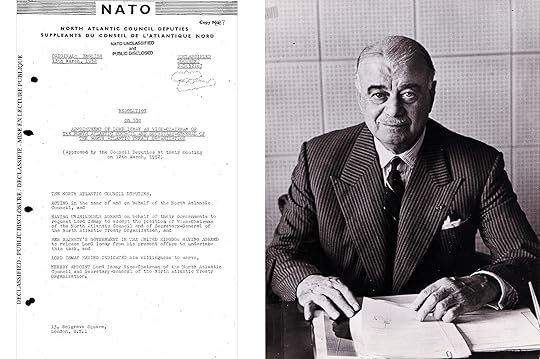
Hastings Lionel Ismay was a Sandhurst educated soldier. He was posted to India and then fought in Somaliland against Mohammed bin Abdullah until 1920. After various staff positions, he became the military secretary to Lord Willingdon of India in 1931. By 1938, he was the Secretary of the Committee of Imperial Defense. During WW2, Ismay was Prime Minister Winston Churchill's chief of staff, accompanying him on several conferences. He retired from the British Army in 1946 and was made a baron in Jan 1947 and later a lord. He served under Lord Mountbatten of Burma as his chief of staff and then was made Secretary of State for Commonwealth Relations. In 1952, he became the first Secretary General of NATO.
Regarding Churchill and Chapter Four:
Nearly every morning one visitor in particular came to Churchill’s bedroom, Major General Hastings Ismay, newly appointed military chief of staff, known lovingly, and universally, as “Pug” for his likeness to that breed of dog.
It was Ismay’s job to serve as an intermediary between Churchill and the chiefs of the three military services, helping them to understand him, and him to understand them.
Source: Larson, Erik. The Splendid and the Vile (p. 29). Crown. Kindle Edition.
Discussion Questions and Topics:
1. What effect did Ismay have on Churchill and Churchill on Ismay. What made Ismay a favorite of the staff and typists (and Colville)? What qualities did Churchill see in Ismay that would make him ultimately a good first Secretary General of NATO?
More:
“IT IS YOUR DUTY TO ACCEPT, PUG.” – CHURCHILL TO ISMAY
and CHURCHILL: “HAVE YOU FORGIVEN ME FOR SENDING YOU TO NATO?” ISMAY: “SIR, YOU WERE RIGHT, AS ALWAYS.”
Lord Hastings Lionel Ismay was NATO’s first Secretary General, a position he was initially reluctant to accept. By the end of his tenure however, Ismay had become the biggest advocate of the organisation he had famously said earlier on in his political career, was created to “keep the Soviet Union out, the Americans in, and the Germans down.”
Link: https://www.nato.int/cps/en/natohq/de...
Introducing the 🇬🇧United Kingdom [The Atlantic Community Series - NATO Documentaries, 1956]
Presentation of the history and contribution of the United Kingdom to Western defense and the Atlantic Community. "Introducing the United Kingdom" is part of a series originally designed as "Know your Allies", and finally titled "the Atlantic Community Series". Its objectives were to familiarize public opinion in each of the member country with the other Alliance members and to emphasize the national contributions to Western culture and political traditions, economic reconstruction and allied defense in the framework of NATO.
The series was produced between 1954 and 1956 and financed by the US government in the context of the Marshall Plan with the cooperation of the Information Service of NATO, and distributed by NATO. The films in the Atlantic Community Series received large non-theatrical distribution and, in some cases, were shown in cinemas and on TV. Language versions were made and distributed with the help of the national governments.
“My country and NATO” tells the story of each one of NATO’s members, using a selection of unique archival materials to take you back in time.
Link: https://youtu.be/ODrja3SmIL4 (excellent little film)
Lord Ismay - NATO (1952)
Video: https://youtu.be/iEkvGFV0_kE
Sylvia Goodman recalls life at the War Cabinet Office during WWII
Video: https://youtu.be/uZWoAcxRbRQ
Article: https://www.thejc.com/news/uk-news/wh...
Sources: North Atlantic Treaty Organization, Wikipedia, Youtube

Ismay (top left) with Roosevelt, Churchill and Admiral Mountbatten at the Casablanca Conference

Hastings Lionel Ismay was a Sandhurst educated soldier. He was posted to India and then fought in Somaliland against Mohammed bin Abdullah until 1920. After various staff positions, he became the military secretary to Lord Willingdon of India in 1931. By 1938, he was the Secretary of the Committee of Imperial Defense. During WW2, Ismay was Prime Minister Winston Churchill's chief of staff, accompanying him on several conferences. He retired from the British Army in 1946 and was made a baron in Jan 1947 and later a lord. He served under Lord Mountbatten of Burma as his chief of staff and then was made Secretary of State for Commonwealth Relations. In 1952, he became the first Secretary General of NATO.
Regarding Churchill and Chapter Four:
Nearly every morning one visitor in particular came to Churchill’s bedroom, Major General Hastings Ismay, newly appointed military chief of staff, known lovingly, and universally, as “Pug” for his likeness to that breed of dog.
It was Ismay’s job to serve as an intermediary between Churchill and the chiefs of the three military services, helping them to understand him, and him to understand them.
Source: Larson, Erik. The Splendid and the Vile (p. 29). Crown. Kindle Edition.
Discussion Questions and Topics:
1. What effect did Ismay have on Churchill and Churchill on Ismay. What made Ismay a favorite of the staff and typists (and Colville)? What qualities did Churchill see in Ismay that would make him ultimately a good first Secretary General of NATO?
More:
“IT IS YOUR DUTY TO ACCEPT, PUG.” – CHURCHILL TO ISMAY
and CHURCHILL: “HAVE YOU FORGIVEN ME FOR SENDING YOU TO NATO?” ISMAY: “SIR, YOU WERE RIGHT, AS ALWAYS.”
Lord Hastings Lionel Ismay was NATO’s first Secretary General, a position he was initially reluctant to accept. By the end of his tenure however, Ismay had become the biggest advocate of the organisation he had famously said earlier on in his political career, was created to “keep the Soviet Union out, the Americans in, and the Germans down.”
Link: https://www.nato.int/cps/en/natohq/de...
Introducing the 🇬🇧United Kingdom [The Atlantic Community Series - NATO Documentaries, 1956]
Presentation of the history and contribution of the United Kingdom to Western defense and the Atlantic Community. "Introducing the United Kingdom" is part of a series originally designed as "Know your Allies", and finally titled "the Atlantic Community Series". Its objectives were to familiarize public opinion in each of the member country with the other Alliance members and to emphasize the national contributions to Western culture and political traditions, economic reconstruction and allied defense in the framework of NATO.
The series was produced between 1954 and 1956 and financed by the US government in the context of the Marshall Plan with the cooperation of the Information Service of NATO, and distributed by NATO. The films in the Atlantic Community Series received large non-theatrical distribution and, in some cases, were shown in cinemas and on TV. Language versions were made and distributed with the help of the national governments.
“My country and NATO” tells the story of each one of NATO’s members, using a selection of unique archival materials to take you back in time.
Link: https://youtu.be/ODrja3SmIL4 (excellent little film)
Lord Ismay - NATO (1952)
Video: https://youtu.be/iEkvGFV0_kE
Sylvia Goodman recalls life at the War Cabinet Office during WWII
Video: https://youtu.be/uZWoAcxRbRQ
Article: https://www.thejc.com/news/uk-news/wh...
Sources: North Atlantic Treaty Organization, Wikipedia, Youtube
message 92:
by
Bentley, Group Founder, Leader, Chief
(last edited Jun 07, 2020 04:10PM)
(new)
-
rated it 4 stars
Dunkirk
A video to start you off with - from the English Heritage
Meet former Army Signalman and Operation Dynamo veteran Richard Sheen at his home in West Wales to discover the true story of the Dunkirk Rescue that was masterminded from the secret war tunnels deep below Dover Castle. Between 1939 and 1942, Richard Sheen was billeted to Dover, where he used radar to plot enemy aircraft crossing the Channel, and communicated their positions to anti-aircraft batteries along the coast. In this interview he reveals what life was like in Dover’s Gun Control Room, his experiences of helping the rescued soldiers off the ships and why Operation Dynamo was a turning point in the war effort - All archive footage supplied by Huntley Film Archives Ltd.
Video: - Operation Dynamo: Interview with a Dunkirk War Veteran - https://youtu.be/u_jbtrp7Zls
and another video - Finest Hour - Part 2 - Dunkirk
Film - Video: https://youtu.be/KSHkDjAAz08
And some actual photos:

The actual city of Dunkirk which was destroyed in 1940 - all you see in the movie Dunkirk are the beaches!!! - these are actual photos - Weiner Library/REX/Shutterstock

British escape route near Dunkirk, littered with wrecked trucks in Summer 1940 - Weiner Library/REX/Shutterstock
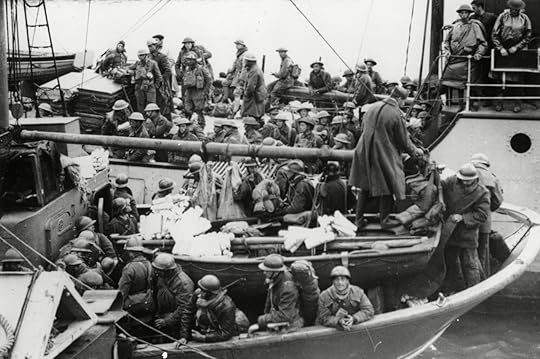
WWII ALLIES RESCUED AT DUNKIRK, UNITED KINGDOM ENGLAND - After a successful emergency sealift from a beachhead at Dunkirk, these British and French soldiers arrive safely at an unknown British port, in June 1940

War material that the Allied troops left behind in Dunkirk in June 1940, when they were evacuated - AP/REX/Shutterstock
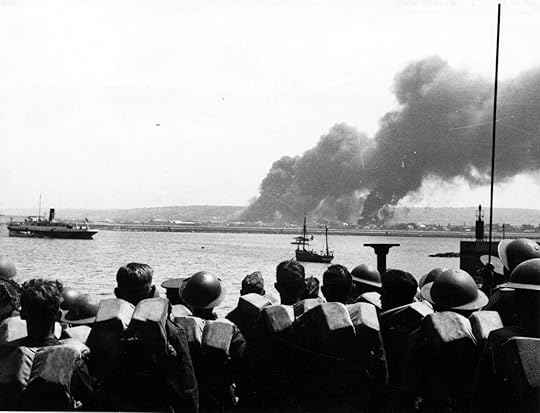
British troops on a ship evacuating them from Dunkirk in 1940 -
REX/Shutterstock

British and French troops on a ship evacuating them from Dunkirk in 1940 - REX/Shutterstock
Background:
Olivia Waxman writes: "It starts in May 10, 1940, with a surprise German blitzkrieg bombarding Holland and the French-Belgian border with air raids, parachute drops and ground attacks. The move came as a surprise to the Allied forces, who had thought any German attack would come at the Maginot Line, a fortification along the French-German border. And it was apparently a surprise to some Germans too, according to Robert Tombs, a historian at the University of Cambridge and a co-editor of Britain and France in Two World Wars: Truth, Myth and Memory, since it was a risky last-minute decision that Nazi dictator Adolf Hitler almost didn’t sign off on.
Belgium and Holland were hit so hard they were forced to surrender, and British troops in France, pushed toward the water by the onslaught of German forces, fought themselves to a point of no return at the French port of Dunkirk. (This map, from the June 10, 1940, issue of TIME, shows the small and shrinking sliver of land onto which they were driven.)"

“Their only chance of surviving was for the army to be brought back to England, [to] protect the island and carry on the war,” says Tombs. “If this had not succeeded, Britain might have had to surrender to Hitler and Germany would have dominated Europe.”
But, if they hoped to escape back to England, they had a logistical problem: the beach at Dunkirk was so shallow that the big ships of the Royal Navy couldn’t reach the stranded soldiers. In a stroke of ingenuity, a call went out for civilian boats to head to Dunkirk to ferry the troops to safety. Complicating the already harrowing rescue was an air raid midway through the operation by the German Luftwaffe. To keep cargo light on the small ships, the troops had to leave their weaponry, tanks, and artillery behind, so that the small boats wouldn’t be overloaded. (“There’s a myth that the British army was unprepared,” Tombs says, but in fact it was just outnumbered, and records show that the Germans marveled at the high-tech quality of the abandoned gear at Dunkirk.)
“Their only chance of surviving was for the army to be brought back to England, [to] protect the island and carry on the war,” says Tombs. “If this had not succeeded, Britain might have had to surrender to Hitler and Germany would have dominated Europe.”
The evacuation is often referred to as “the miracle of Dunkirk” because only 30,000 to 45,000 were expected to be rescued, but in fact, between May 26, 1940, and June 3, 1940, more than 300,000 troops were able to get off the beach."
Remainder of article: https://time.com/4865358/dunkirk-hist...
More:
Not Everyone Escaped at Dunkirk. This Is What Happened After the Rescue
Link: https://time.com/4869347/dunkirk-afte...
There is a 1958 movie version of Dunkirk that might be better!
Link: https://www.bfi.org.uk/news-opinion/n...
Link: https://youtu.be/xsmW5Dd7BVA
Operation Dynamo: Things You Need to Know About the Dunkirk Evacuation
Link: https://www.english-heritage.org.uk/v...
THE FALL OF FRANCE IN THE SECOND WORLD WAR
Link: https://www.english-heritage.org.uk/v...
Discussion Questions and Topics:
1. This is a moral question - was it right for Churchill to promise to send fighter aircraft to France and then because the country’s fate seemed so tenuous to decide there was little point. Churchill decided arbitrarily every fighter was needed in England to defend against the coming invasion.
2. And according to Mandelbaum - who viewed the movie Dunkirk - "Where in the film are the 120,000 French soldiers who were also evacuated from Dunkirk? Where are the 40,000 who sacrificed themselves to defend the city against a superior enemy in weaponry and numbers?"
And according to Robert Tombs (historian) - “I think the thing the British entirely forget or have never known, is that it was actually the French army that was helping to hold the Germans off and sacrificing themselves while the British army was evacuated,” says Tombs. “A lot of Brits think that the French did not fight, but the French army helped to save the British army.
What are your thoughts about the French being not even a footnote in the movie Dunkirk and not even being a footnote in the memories of the British regarding Dunkirk? According to many - why is the movie Dunkirk only shot on the beaches?
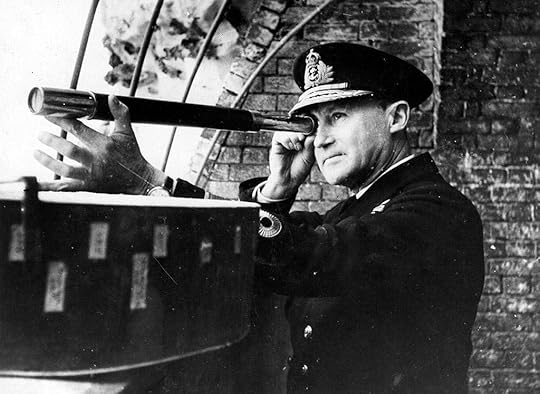
Vice-Admiral Ramsay on the balcony of Admiralty Casemate, one of the tunnels under Dover Castle, in April 1941. Ramsay was the officer in command of Operation Dynamo
Sources: Larson, Erik. The Splendid and the Vile (p. 35). Crown. Kindle Edition, Time, English Heritage, Youtube, Shutterstock, Weiner Library
More:
 by
by
 Elleston Trevor
Elleston Trevor
 by
by
 Walter Lord
Walter Lord
A video to start you off with - from the English Heritage
Meet former Army Signalman and Operation Dynamo veteran Richard Sheen at his home in West Wales to discover the true story of the Dunkirk Rescue that was masterminded from the secret war tunnels deep below Dover Castle. Between 1939 and 1942, Richard Sheen was billeted to Dover, where he used radar to plot enemy aircraft crossing the Channel, and communicated their positions to anti-aircraft batteries along the coast. In this interview he reveals what life was like in Dover’s Gun Control Room, his experiences of helping the rescued soldiers off the ships and why Operation Dynamo was a turning point in the war effort - All archive footage supplied by Huntley Film Archives Ltd.
Video: - Operation Dynamo: Interview with a Dunkirk War Veteran - https://youtu.be/u_jbtrp7Zls
and another video - Finest Hour - Part 2 - Dunkirk
Film - Video: https://youtu.be/KSHkDjAAz08
And some actual photos:

The actual city of Dunkirk which was destroyed in 1940 - all you see in the movie Dunkirk are the beaches!!! - these are actual photos - Weiner Library/REX/Shutterstock

British escape route near Dunkirk, littered with wrecked trucks in Summer 1940 - Weiner Library/REX/Shutterstock

WWII ALLIES RESCUED AT DUNKIRK, UNITED KINGDOM ENGLAND - After a successful emergency sealift from a beachhead at Dunkirk, these British and French soldiers arrive safely at an unknown British port, in June 1940

War material that the Allied troops left behind in Dunkirk in June 1940, when they were evacuated - AP/REX/Shutterstock

British troops on a ship evacuating them from Dunkirk in 1940 -
REX/Shutterstock

British and French troops on a ship evacuating them from Dunkirk in 1940 - REX/Shutterstock
Background:
Olivia Waxman writes: "It starts in May 10, 1940, with a surprise German blitzkrieg bombarding Holland and the French-Belgian border with air raids, parachute drops and ground attacks. The move came as a surprise to the Allied forces, who had thought any German attack would come at the Maginot Line, a fortification along the French-German border. And it was apparently a surprise to some Germans too, according to Robert Tombs, a historian at the University of Cambridge and a co-editor of Britain and France in Two World Wars: Truth, Myth and Memory, since it was a risky last-minute decision that Nazi dictator Adolf Hitler almost didn’t sign off on.
Belgium and Holland were hit so hard they were forced to surrender, and British troops in France, pushed toward the water by the onslaught of German forces, fought themselves to a point of no return at the French port of Dunkirk. (This map, from the June 10, 1940, issue of TIME, shows the small and shrinking sliver of land onto which they were driven.)"

“Their only chance of surviving was for the army to be brought back to England, [to] protect the island and carry on the war,” says Tombs. “If this had not succeeded, Britain might have had to surrender to Hitler and Germany would have dominated Europe.”
But, if they hoped to escape back to England, they had a logistical problem: the beach at Dunkirk was so shallow that the big ships of the Royal Navy couldn’t reach the stranded soldiers. In a stroke of ingenuity, a call went out for civilian boats to head to Dunkirk to ferry the troops to safety. Complicating the already harrowing rescue was an air raid midway through the operation by the German Luftwaffe. To keep cargo light on the small ships, the troops had to leave their weaponry, tanks, and artillery behind, so that the small boats wouldn’t be overloaded. (“There’s a myth that the British army was unprepared,” Tombs says, but in fact it was just outnumbered, and records show that the Germans marveled at the high-tech quality of the abandoned gear at Dunkirk.)
“Their only chance of surviving was for the army to be brought back to England, [to] protect the island and carry on the war,” says Tombs. “If this had not succeeded, Britain might have had to surrender to Hitler and Germany would have dominated Europe.”
The evacuation is often referred to as “the miracle of Dunkirk” because only 30,000 to 45,000 were expected to be rescued, but in fact, between May 26, 1940, and June 3, 1940, more than 300,000 troops were able to get off the beach."
Remainder of article: https://time.com/4865358/dunkirk-hist...
More:
Not Everyone Escaped at Dunkirk. This Is What Happened After the Rescue
Link: https://time.com/4869347/dunkirk-afte...
There is a 1958 movie version of Dunkirk that might be better!
Link: https://www.bfi.org.uk/news-opinion/n...
Link: https://youtu.be/xsmW5Dd7BVA
Operation Dynamo: Things You Need to Know About the Dunkirk Evacuation
Link: https://www.english-heritage.org.uk/v...
THE FALL OF FRANCE IN THE SECOND WORLD WAR
Link: https://www.english-heritage.org.uk/v...
Discussion Questions and Topics:
1. This is a moral question - was it right for Churchill to promise to send fighter aircraft to France and then because the country’s fate seemed so tenuous to decide there was little point. Churchill decided arbitrarily every fighter was needed in England to defend against the coming invasion.
2. And according to Mandelbaum - who viewed the movie Dunkirk - "Where in the film are the 120,000 French soldiers who were also evacuated from Dunkirk? Where are the 40,000 who sacrificed themselves to defend the city against a superior enemy in weaponry and numbers?"
And according to Robert Tombs (historian) - “I think the thing the British entirely forget or have never known, is that it was actually the French army that was helping to hold the Germans off and sacrificing themselves while the British army was evacuated,” says Tombs. “A lot of Brits think that the French did not fight, but the French army helped to save the British army.
What are your thoughts about the French being not even a footnote in the movie Dunkirk and not even being a footnote in the memories of the British regarding Dunkirk? According to many - why is the movie Dunkirk only shot on the beaches?

Vice-Admiral Ramsay on the balcony of Admiralty Casemate, one of the tunnels under Dover Castle, in April 1941. Ramsay was the officer in command of Operation Dynamo
Sources: Larson, Erik. The Splendid and the Vile (p. 35). Crown. Kindle Edition, Time, English Heritage, Youtube, Shutterstock, Weiner Library
More:
 by
by
 Elleston Trevor
Elleston Trevor by
by
 Walter Lord
Walter Lord
message 93:
by
Bentley, Group Founder, Leader, Chief
(last edited Jun 07, 2020 06:14PM)
(new)
-
rated it 4 stars
More on Dunkirk
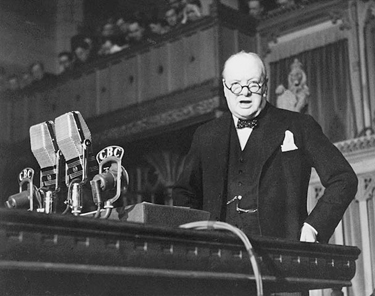
Dunkirk: The Great Escape (Documentary)
A BBC Timewatch documentary about the Dunkirk
evacuation from 1990 as told by those who were there.
Video: https://youtu.be/igT2rs3za6E
The Miracle of Dunkirk: An Illustrated History
Video: https://youtu.be/LIQ4qlPbyy8
Remember Dunkirk: Timeline of a Miracle
Video: https://youtu.be/NjGXDzoheyU
Why did the Luftwaffe 'fail' at Dunkirk ?
Video:https://youtu.be/6L1ifGA7zsE
Dunkirk VR Experience: Find Yourself On The Shores Of Dunkirk Fighting To Survive | 360 | TIME
Video: https://youtu.be/zgdo7-RRjgo
Churchill:
WE SHALL NEVER SURRENDER speech by Winston Churchill (We Shall Fight on the Beaches)
Video: https://youtu.be/s_LncVnecLA

Dunkirk: The Great Escape (Documentary)
A BBC Timewatch documentary about the Dunkirk
evacuation from 1990 as told by those who were there.
Video: https://youtu.be/igT2rs3za6E
The Miracle of Dunkirk: An Illustrated History
Video: https://youtu.be/LIQ4qlPbyy8
Remember Dunkirk: Timeline of a Miracle
Video: https://youtu.be/NjGXDzoheyU
Why did the Luftwaffe 'fail' at Dunkirk ?
Video:https://youtu.be/6L1ifGA7zsE
Dunkirk VR Experience: Find Yourself On The Shores Of Dunkirk Fighting To Survive | 360 | TIME
Video: https://youtu.be/zgdo7-RRjgo
Churchill:
WE SHALL NEVER SURRENDER speech by Winston Churchill (We Shall Fight on the Beaches)
Video: https://youtu.be/s_LncVnecLA
message 94:
by
Bentley, Group Founder, Leader, Chief
(last edited Jun 07, 2020 06:43PM)
(new)
-
rated it 4 stars
And so Chapter Five begins:
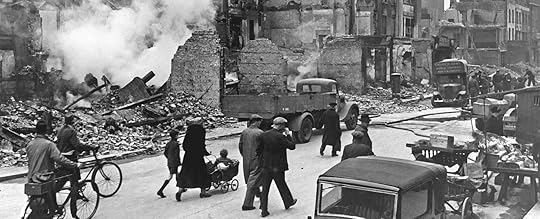
CHAPTER 5
Moondread

The Siren Suit - the "Onesie"
“THE OBJECT OF THIS PAPER,” the report began, “is to investigate the means whereby we could continue to fight single-handed if French resistance were to collapse completely, involving the loss of a substantial proportion of the British Expeditionary Force, and the French Government were to make terms with Germany.”
Labeled “MOST SECRET,” it made for a frightening read. One of its fundamental assumptions was that the United States would provide “full economic and financial support.”
Without this, the report noted in italics, “we do not think we could continue the war with any chance of success.” It forecast that only a fragment of the BEF could be evacuated from France.
More:
Winston's Churchill Daily Routine before the War
Despite all this activity Churchill’s daily routine changed little during these years. He awoke about 7:30 a.m. and remained in bed for a substantial breakfast and reading of mail and all the national newspapers. For the next couple of hours, still in bed, he worked, dictating to his secretaries.
At 11:00 a.m., he arose, bathed, and perhaps took a walk around the garden, and took a weak whisky and soda to his study.
At 1:00 p.m. he joined guests and family for a three-course lunch. Clementine drank claret, Winston champagne, preferable Pol Roger served at a specific temperature, port brandy and cigars. When lunch ended, about 3:30 p.m. he returned to his study to work, or supervised work on his estate, or played cards or backgammon with Clementine.
At 5:00 p.m., after another weak whisky and soda, he went to be for an hour and a half. He said this siesta, a habit gained in Cuba, allowed him to work 1 1/2 days in every 24 hours. At 6:30 p.m. he awoke, bathed again, and dressed for dinner at 8:00 p.m.
Dinner was the focal-point and highlight of Churchill’s day. Table talk, dominated by Churchill, was as important as the meal. Sometimes, depending on the company, drinks and cigars extended the event well past midnight. The guests retired, Churchill returned to his study for another hour or so of work.
Medical mystery: Winston Churchill's most secret battle
by Allan B. Schwartz, For the Inquirer
Link: https://www.inquirer.com/philly/healt...
Allen, Julie. “Fond Memories of the Siren Suit by a Child in Penge,” July 22, 2005. BBC WW2 People’s War Archives. http://www.bbc.co.uk/history/ww2peopl...
Ryan, Rob. “All for Onesie: The Siren Suit,” February 28, 2016. Turnbull & Asser. http://turnbullandasser.com/all-for-o...
Torsten. “Churchill’s Romper Suit and Siren Suit,” February 1, 2017. Sartorial Notes. https://sartorialnotes.com/2017/02/01...
The Siren Suit
Link: https://eng410wwiilit.commons.gc.cuny...
Sources: The Philadelphia Inquirer, The Churchill Institute, CUNY Academic Commons, Larson, Erik. The Splendid and the Vile (p. 39). Crown. Kindle Edition.

CHAPTER 5
Moondread

The Siren Suit - the "Onesie"
“THE OBJECT OF THIS PAPER,” the report began, “is to investigate the means whereby we could continue to fight single-handed if French resistance were to collapse completely, involving the loss of a substantial proportion of the British Expeditionary Force, and the French Government were to make terms with Germany.”
Labeled “MOST SECRET,” it made for a frightening read. One of its fundamental assumptions was that the United States would provide “full economic and financial support.”
Without this, the report noted in italics, “we do not think we could continue the war with any chance of success.” It forecast that only a fragment of the BEF could be evacuated from France.
More:
Winston's Churchill Daily Routine before the War
Despite all this activity Churchill’s daily routine changed little during these years. He awoke about 7:30 a.m. and remained in bed for a substantial breakfast and reading of mail and all the national newspapers. For the next couple of hours, still in bed, he worked, dictating to his secretaries.
At 11:00 a.m., he arose, bathed, and perhaps took a walk around the garden, and took a weak whisky and soda to his study.
At 1:00 p.m. he joined guests and family for a three-course lunch. Clementine drank claret, Winston champagne, preferable Pol Roger served at a specific temperature, port brandy and cigars. When lunch ended, about 3:30 p.m. he returned to his study to work, or supervised work on his estate, or played cards or backgammon with Clementine.
At 5:00 p.m., after another weak whisky and soda, he went to be for an hour and a half. He said this siesta, a habit gained in Cuba, allowed him to work 1 1/2 days in every 24 hours. At 6:30 p.m. he awoke, bathed again, and dressed for dinner at 8:00 p.m.
Dinner was the focal-point and highlight of Churchill’s day. Table talk, dominated by Churchill, was as important as the meal. Sometimes, depending on the company, drinks and cigars extended the event well past midnight. The guests retired, Churchill returned to his study for another hour or so of work.
Medical mystery: Winston Churchill's most secret battle
by Allan B. Schwartz, For the Inquirer
Link: https://www.inquirer.com/philly/healt...
Allen, Julie. “Fond Memories of the Siren Suit by a Child in Penge,” July 22, 2005. BBC WW2 People’s War Archives. http://www.bbc.co.uk/history/ww2peopl...
Ryan, Rob. “All for Onesie: The Siren Suit,” February 28, 2016. Turnbull & Asser. http://turnbullandasser.com/all-for-o...
Torsten. “Churchill’s Romper Suit and Siren Suit,” February 1, 2017. Sartorial Notes. https://sartorialnotes.com/2017/02/01...
The Siren Suit
Link: https://eng410wwiilit.commons.gc.cuny...
Sources: The Philadelphia Inquirer, The Churchill Institute, CUNY Academic Commons, Larson, Erik. The Splendid and the Vile (p. 39). Crown. Kindle Edition.
This is the reading assignment for Week Three - June 8th - June 14th
Week Three - June 8th - June 14th
Chapter 6: Göring
Chapter 7: Sufficient Bliss
Chapter 8: The First Bombs
Week Three - June 8th - June 14th
Chapter 6: Göring
Chapter 7: Sufficient Bliss
Chapter 8: The First Bombs
And so Chapter Six begins: (setting the stage for the Battle of Britain)

Opulent: after a bout of illness, Churchill greeted the world's military leaders in his dressing gown CREDIT: BETTMANN
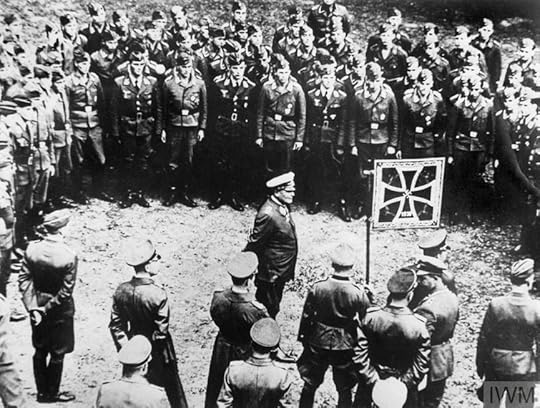
Luftwaffe Commander-in-Chief Hermann Göring addresses a group of German pilots during the Battle of Britain. The Luftwaffe was officially created on 26 February 1935, with Göring as its commander-in-chief. He had been a celebrated First World War fighter pilot and was one of Hitler’s closest political associates. The Luftwaffe enjoyed a rapid expansion in its first five years, in large measure due to Göring’s considerable political influence.
CHAPTER 6
Göring
"ON THAT FRIDAY, MAY 24, Hitler made two decisions that would influence the duration and character of the coming war. At noon, on the advice of a trusted senior general, Hitler ordered his armored divisions to halt their advance against the British Expeditionary Force.
Hitler agreed with the general’s recommendation that his tanks and crews be given a chance to regroup before a planned advance to the south. German forces already had sustained major losses in the so-called campaign in the west: 27,074 soldiers dead, 111,034 more wounded, and another 18,384 missing—a blow to the German public, who had been led to expect a brief, tidy war.
The halt order, which gave the British a lifesaving pause, perplexed British and German commanders alike. The Luftwaffe’s general field marshal Albert Kesselring later called it a “fatal error.” Kesselring was all the more surprised when suddenly the task of destroying the fleeing British force was assigned to him and his air fleet.
Luftwaffe chief Hermann Göring had promised Hitler that his air force could destroy the BEF on its own—a promise that had little grounding in reality, Kesselring knew, especially given the exhaustion of his pilots and the spirited attacks by RAF pilots flying
the latest Spitfires.
That same Friday, further swayed by Göring’s belief in the near-magical power of his air force, Hitler issued Directive No. 13, one of a series of broad strategic orders he would issue throughout the war.
“The task of the Air Force will be to break all enemy resistance on the part of the surrounded forces, to prevent the escape of the English forces across the Channel,” the directive read.
It authorized the Luftwaffe “to attack the English homeland in the fullest manner, as soon as sufficient forces are available.”
More:
"Three air fleets – Luftflotten 2, 3 and 5 – were deployed to face RAF Fighter Command from across the English Channel and the North Sea. Luftflotte 2, commanded by Field Marshal Albert Kesselring, undertook the main weight of operations against the south-east of England. Luftflotte 3, under the leadership of Field Marshal Hugo Sperrle, concentrated on targets in the western half of England and General Hans Stumpff’s Luftflotte 5 was to be used for diversionary attacks against northern Britain.
The Luftwaffe suffered various problems which hampered its effectiveness in the Battle of Britain. It was designed as a close-support weapon moving forward with ground troops, not as an instrument for a strategic bombing campaign against a determined opposing fighter force."
Remainder of article:
Link: https://www.iwm.org.uk/history/how-th...
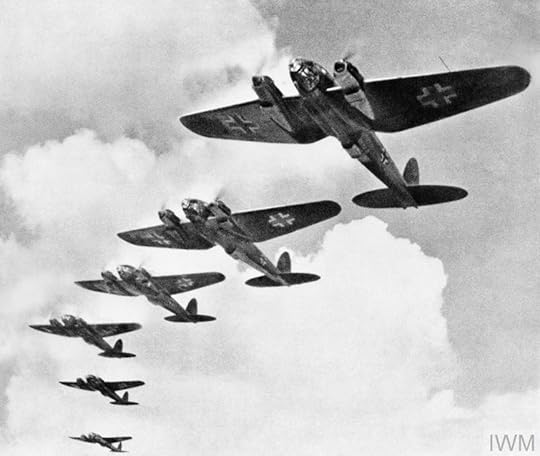
HEINKEL HE 111 BOMBERS IN FORMATION - The He 111H was the mainstay of the German bomber force in 1940. To escort and protect its bombers, the Luftwaffe had two fighters; the single-engined single-seat Messerschmitt Bf 109 and the twin-engined two-seater Messerschmitt Bf 110
See article: https://www.iwm.org.uk/history/how-th...
 by Derek Wood (no photo)
by Derek Wood (no photo)
 by
by
 Adolf Galland
Adolf Galland
Sources: Larson, Erik. The Splendid and the Vile (p. 48). Crown. Kindle Edition, Imperial War Museum

Opulent: after a bout of illness, Churchill greeted the world's military leaders in his dressing gown CREDIT: BETTMANN

Luftwaffe Commander-in-Chief Hermann Göring addresses a group of German pilots during the Battle of Britain. The Luftwaffe was officially created on 26 February 1935, with Göring as its commander-in-chief. He had been a celebrated First World War fighter pilot and was one of Hitler’s closest political associates. The Luftwaffe enjoyed a rapid expansion in its first five years, in large measure due to Göring’s considerable political influence.
CHAPTER 6
Göring
"ON THAT FRIDAY, MAY 24, Hitler made two decisions that would influence the duration and character of the coming war. At noon, on the advice of a trusted senior general, Hitler ordered his armored divisions to halt their advance against the British Expeditionary Force.
Hitler agreed with the general’s recommendation that his tanks and crews be given a chance to regroup before a planned advance to the south. German forces already had sustained major losses in the so-called campaign in the west: 27,074 soldiers dead, 111,034 more wounded, and another 18,384 missing—a blow to the German public, who had been led to expect a brief, tidy war.
The halt order, which gave the British a lifesaving pause, perplexed British and German commanders alike. The Luftwaffe’s general field marshal Albert Kesselring later called it a “fatal error.” Kesselring was all the more surprised when suddenly the task of destroying the fleeing British force was assigned to him and his air fleet.
Luftwaffe chief Hermann Göring had promised Hitler that his air force could destroy the BEF on its own—a promise that had little grounding in reality, Kesselring knew, especially given the exhaustion of his pilots and the spirited attacks by RAF pilots flying
the latest Spitfires.
That same Friday, further swayed by Göring’s belief in the near-magical power of his air force, Hitler issued Directive No. 13, one of a series of broad strategic orders he would issue throughout the war.
“The task of the Air Force will be to break all enemy resistance on the part of the surrounded forces, to prevent the escape of the English forces across the Channel,” the directive read.
It authorized the Luftwaffe “to attack the English homeland in the fullest manner, as soon as sufficient forces are available.”
More:
"Three air fleets – Luftflotten 2, 3 and 5 – were deployed to face RAF Fighter Command from across the English Channel and the North Sea. Luftflotte 2, commanded by Field Marshal Albert Kesselring, undertook the main weight of operations against the south-east of England. Luftflotte 3, under the leadership of Field Marshal Hugo Sperrle, concentrated on targets in the western half of England and General Hans Stumpff’s Luftflotte 5 was to be used for diversionary attacks against northern Britain.
The Luftwaffe suffered various problems which hampered its effectiveness in the Battle of Britain. It was designed as a close-support weapon moving forward with ground troops, not as an instrument for a strategic bombing campaign against a determined opposing fighter force."
Remainder of article:
Link: https://www.iwm.org.uk/history/how-th...

HEINKEL HE 111 BOMBERS IN FORMATION - The He 111H was the mainstay of the German bomber force in 1940. To escort and protect its bombers, the Luftwaffe had two fighters; the single-engined single-seat Messerschmitt Bf 109 and the twin-engined two-seater Messerschmitt Bf 110
See article: https://www.iwm.org.uk/history/how-th...
 by Derek Wood (no photo)
by Derek Wood (no photo) by
by
 Adolf Galland
Adolf GallandSources: Larson, Erik. The Splendid and the Vile (p. 48). Crown. Kindle Edition, Imperial War Museum
message 97:
by
Bentley, Group Founder, Leader, Chief
(last edited Jun 07, 2020 07:27PM)
(new)
-
rated it 4 stars
Chapter Overviews and Summaries
Chapter 6: Göring
See Message 96
Chapter 7: Sufficient Bliss
In this chapter, Colville is in love, the start of Operation Dynamo, Goring underestimates the British resolve.
Chapter 8: The First Bombs
Operation to remove troops from Dunkirk was more successful than first imagined. Churchill give stirring speech.
Chapter 6: Göring
See Message 96
Chapter 7: Sufficient Bliss
In this chapter, Colville is in love, the start of Operation Dynamo, Goring underestimates the British resolve.
Chapter 8: The First Bombs
Operation to remove troops from Dunkirk was more successful than first imagined. Churchill give stirring speech.
message 98:
by
Bentley, Group Founder, Leader, Chief
(last edited Jun 09, 2020 12:56AM)
(new)
-
rated it 4 stars
Today's Progress: June 7, 2020
✓Week Two's Assignment began Monday - June 1st
It is never too late to join a buddy read.
✓Week Two - June 1st - June 7th -
✓Chapter 3: London and Washington - page 24 - The moderator has completed adding material, discussion questions, etc. for this chapter - Complete
✓Chapter 4: Galvanized - page 27 - The moderator has completed adding material, discussion questions, etc. for this chapter - Complete
✓Chapter 5: Moondread - page 39 - The moderator has completed adding material, discussion questions, etc. for this chapter - Complete
The moderator got ahead a bit because of multiple discussions that are ongoing and completed the posting for the first chapter in next week's assignment
Week Three - June 8th - June 14th - beginning
✓Chapter 6: Göring - The moderator has completed adding material, discussion questions, etc. for this chapter - Complete
Chapter 7: Sufficient Bliss - next week
Chapter 8: The First Bombs - next week
Good night!
Please post and discuss any aspect of any pages through the end of Chapter 5 - with no spoilers necessary, If you go ahead - use spoiler html or post on the glossary thread.
✓Week Two's Assignment began Monday - June 1st
It is never too late to join a buddy read.
✓Week Two - June 1st - June 7th -
✓Chapter 3: London and Washington - page 24 - The moderator has completed adding material, discussion questions, etc. for this chapter - Complete
✓Chapter 4: Galvanized - page 27 - The moderator has completed adding material, discussion questions, etc. for this chapter - Complete
✓Chapter 5: Moondread - page 39 - The moderator has completed adding material, discussion questions, etc. for this chapter - Complete
The moderator got ahead a bit because of multiple discussions that are ongoing and completed the posting for the first chapter in next week's assignment
Week Three - June 8th - June 14th - beginning
✓Chapter 6: Göring - The moderator has completed adding material, discussion questions, etc. for this chapter - Complete
Chapter 7: Sufficient Bliss - next week
Chapter 8: The First Bombs - next week
Good night!
Please post and discuss any aspect of any pages through the end of Chapter 5 - with no spoilers necessary, If you go ahead - use spoiler html or post on the glossary thread.
Today's Progress - June 8th, 2020
Week Three - June 8th - June 14th - beginning
✓Chapter 6: Göring - The moderator has completed adding material, discussion questions, etc. for this chapter - Complete
Chapter 7: Sufficient Bliss - this week
Chapter 8: The First Bombs - this week
Good night!
Please post and discuss any aspect of any pages through the end of Chapter 8 - with no spoilers necessary, If you go ahead - use spoiler html or post on the glossary thread.
We are still at the same new spot. Chapter Six has been completed from the moderator's viewpoint - but now it is up to you to respond to some of the discussion topics and questions.
Chapter Seven and Eight will be done this week.
Week Three - June 8th - June 14th - beginning
✓Chapter 6: Göring - The moderator has completed adding material, discussion questions, etc. for this chapter - Complete
Chapter 7: Sufficient Bliss - this week
Chapter 8: The First Bombs - this week
Good night!
Please post and discuss any aspect of any pages through the end of Chapter 8 - with no spoilers necessary, If you go ahead - use spoiler html or post on the glossary thread.
We are still at the same new spot. Chapter Six has been completed from the moderator's viewpoint - but now it is up to you to respond to some of the discussion topics and questions.
Chapter Seven and Eight will be done this week.
message 100:
by
Bentley, Group Founder, Leader, Chief
(last edited Jun 10, 2020 06:05PM)
(new)
-
rated it 4 stars
Winston Churchill: Hero or villain? - BBC News - Today's News
https://www.youtube.com/watch?v=cIZiS...
Source: BBC News
https://www.youtube.com/watch?v=cIZiS...
Source: BBC News
Books mentioned in this topic
Franklin Delano Roosevelt: Champion of Freedom (other topics)The Patriarch: The Remarkable Life and Turbulent Times of Joseph P. Kennedy (other topics)
The Kennedys Amidst the Gathering Storm: A Thousand Days in London, 1938-1940 (other topics)
Dunkirk Lib/E: The History Behind the Major Motion Picture (other topics)
America's Global Role: Essays and Reviews on National Security, Geopolitics, and War (other topics)
More...
Authors mentioned in this topic
Conrad Black (other topics)David Nasaw (other topics)
Will Swift (other topics)
Joshua Levine (other topics)
Francis Sempa (other topics)
More...





The Maginot Line
The Maginot Line (French: Ligne Maginot, IPA: [liɲ maʒino]), named after the French Minister of War - André Maginot, is a line of concrete fortifications, obstacles, and weapon installations built by France in the 1930s to deter invasion by Germany and force them to move around the fortifications. Constructed on the French side of its borders with Italy, Switzerland, Germany, and Luxembourg, the line did not extend to the English Channel due to French strategy that envisioned a move into Belgium to counter a German assault.
Based on France's experience with trench warfare during World War I, the massive Maginot Line was built in the run-up to World War II, after the Locarno Conference gave rise to a fanciful and optimistic "Locarno spirit".
French military experts extolled the Line as a work of genius that would deter German aggression, because it would slow an invasion force long enough for French forces to mobilise and counterattack.
The Maginot Line was impervious to most forms of attack, including aerial bombings and tank fire, and had underground railways as a backup; it also had state-of-the-art living conditions for garrisoned troops, supplying air conditioning and eating areas for their comfort.
Instead of attacking directly, the Germans invaded through the Low Countries, bypassing the Line to the north. French and British officers had anticipated this: when Germany invaded the Netherlands and Belgium, they carried out plans to form an aggressive front that cut across Belgium and connected to the Maginot Line.
However, the French line was weak near the Ardennes forest. Marshal Maurice Gamelin, when drafting the Dyle Plan, believed this region, with its rough terrain, would be an unlikely invasion route of German forces; if it were traversed, it would be done at a slow rate that would allow the French time to bring up reserves and counterattack.
The German Army, having reformulated their plans from a repeat of the First World War-era plan, became aware of and exploited this weak point in the French defensive front.
A rapid advance through the forest and across the River Meuse encircled much of the Allied forces, resulting in a sizeable force being evacuated at Dunkirk leaving the forces to the south unable to mount an effective resistance to the German invasion of France.
The line has since become a metaphor for expensive efforts that offer a false sense of security.
Remainder of article:
https://en.wikipedia.org/wiki/Maginot...
Source: Wikipedia
The amunitions entrance to Ouvrage Schoenenbourg along the Maginot Line in Alsace
The principal fortified section of the Maginot Line
Block 14 at Ouvrage Hochwald in 1940
Side view diagram of the operation of a retractable turret: 75 mm gun of block 3 in Ouvrage Schoenenbourg
Casemate of Dambach Nord, Fortified Sector of the Vosges, Sub-sector of Philippsbourg
Layout of Ouvrage Hackenberg, one of the largest fortress complexes
Blockhouse MOM (Main d'Oeuvre Militaire) de Richtolsheim – Secteur Fortifié de Colmar – Sous secteur de Hilsenheim
Anti-tank rails around casemate 9 of the Hochwald ditch
Cloche GFM (Ouvrage de l'Agaisen)
Cloche JM (Ouvrage de l'Agaisen)
Cloche GFM (Ouvrage de l'Agaisen)
AM Bell (at the work of Welschhof)
Cloche LG (Ouvrage de Latiremont)
Cloche VP (Observatoire du Hackenberg)
Cloche VDP (Ouvrage de Schoenenbourg)
75 mm Retractable turret (Fortress Schoenenbourg - Maginot Line)- Turret Model -1932
Fort Saint-Gobain, Modane 81 mm mortar
Corridor inside the Fort Saint-Gobain near Modane in the Alps. The Decauville
Combat block 1 at the fortress Limeiln (ouvrage Four-à-Chaux, Alsace), showing signs of German testing of explosives inside some fortresses between 1942 and 1944 - What remains of block 1 of the fort after the German experiments. (Four à Chaux, Alsace)
The view from a battery at Ouvrage Schoenenbourg in Alsace. Notice the retractable turret in the left foreground. Author: John C. Watkins V, uploaded to en.wikipedia.org by en:User:Jorge1767
More:
The Maginot Line, the massive series of fortifications built by France in the 1930s to defend its borders with Germany and Italy, is perhaps the most maligned collection of fortifications ever built. Despite being a technological marvel, and the most sophisticated and complex set of fortifications built up to that time, it failed to save France from crushing defeat in 1940. Yet there are those who argue that it accomplished exactly what it was designed to do.
This book provides a concise and informative treatment of the Maginot Line, from North-East France to the Mediterranean. Packed with plans, contemporary and modern images, plus digital artwork, it presents a detailed visual exploration of this famous fortification system.
Video: Keeping memories of France's Maginot Line alive
Named after the French minister of war from the time, the Maginot Line went down in history as the symbol of the French defeat of 1940. This long succession of underground fortresses, from Alsace to the Ardennes, was said to be "impassable" but did not keep the German troops at bay for long. Today, enthusiasts are making sure the Maginot Line is not forgotten, by taking care of what remains of the fortifications.
Link to Video: https://youtu.be/ImzcepfAa4M
Sources: France 24, Wikipedia, Youtube